- AI Fire
- Posts
- 🤪 MIT Study: AI Is Making People 17% DUMBER (Here's How To Get Smarter)
🤪 MIT Study: AI Is Making People 17% DUMBER (Here's How To Get Smarter)
The secret is active engagement, not passive use. Here are 3 workflows to build an AI-augmented mind that learns 2x faster

🧠 When You Use an AI Assistant, What's Your REAL Goal?This guide is about using AI to make yourself smarter. When you open an AI like Gemini or ChatGPT, what are you primarily trying to do? |
Table of Contents
3 Revolutionary NotebookLM + Gemini 2.5 Workflows to Supercharge Your Cognitive Abilities
Recent MIT research revealed something shocking: most people using AI are literally making themselves 17% dumber, with lower test scores, less brain activity and worse memory. But buried within that same study lies a powerful secret - when used correctly, AI can double your learning speed and help you outperform 91% of people in creativity tests.
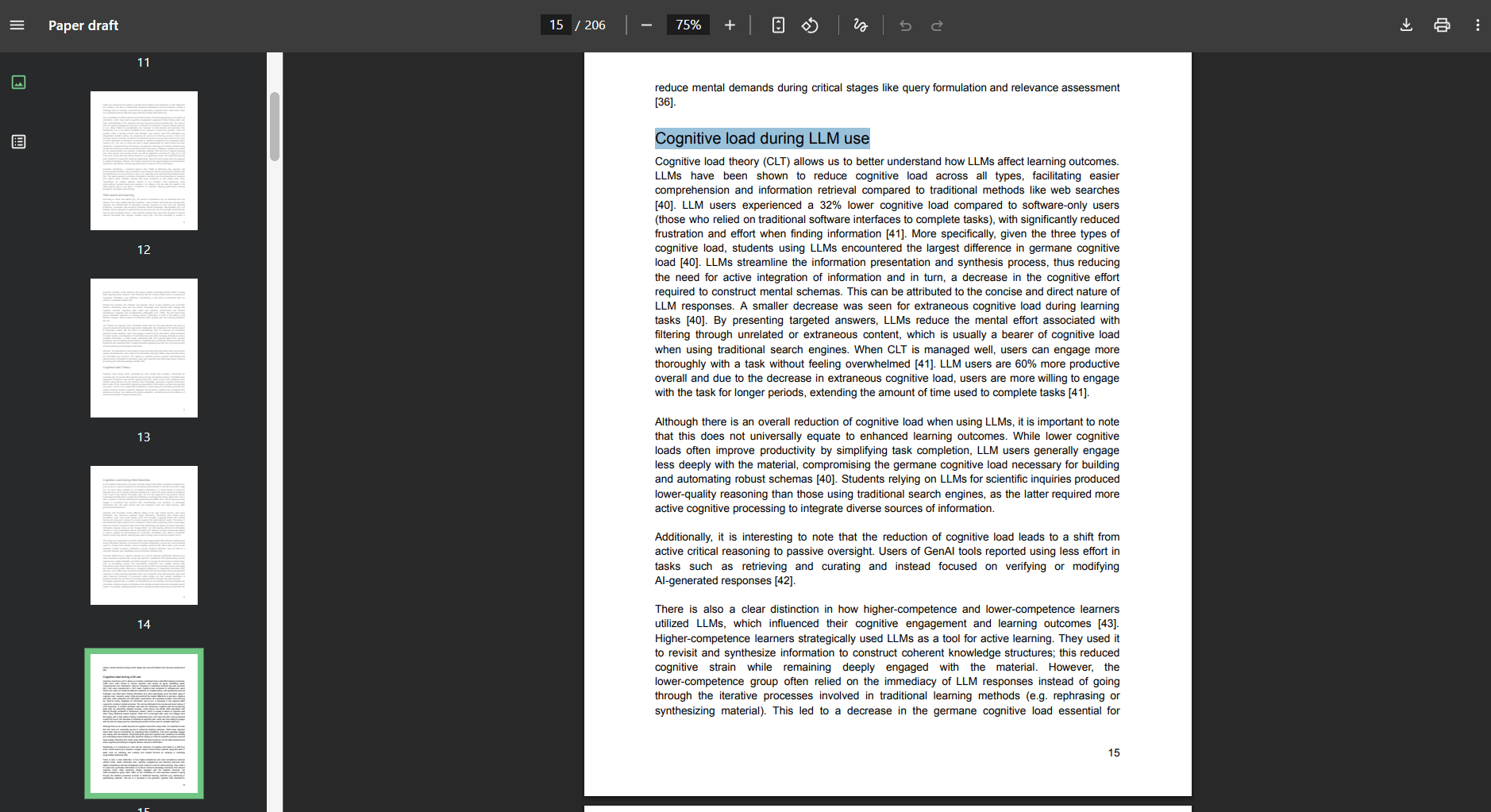
The critical difference? Treating AI as your intellectual sparring partner rather than your replacement thinker. This is the core of an AI-augmented mindset.
In this AI-dominated era, the winners won't be those who let AI think for them but those who use AI to think through previously impossible challenges. Whether your goal is to become the next Leonardo da Vinci or simply develop Sir Isaac Newton-level analytical abilities, the change in how you think starts with these three revolutionary, AI-augmented workflows.
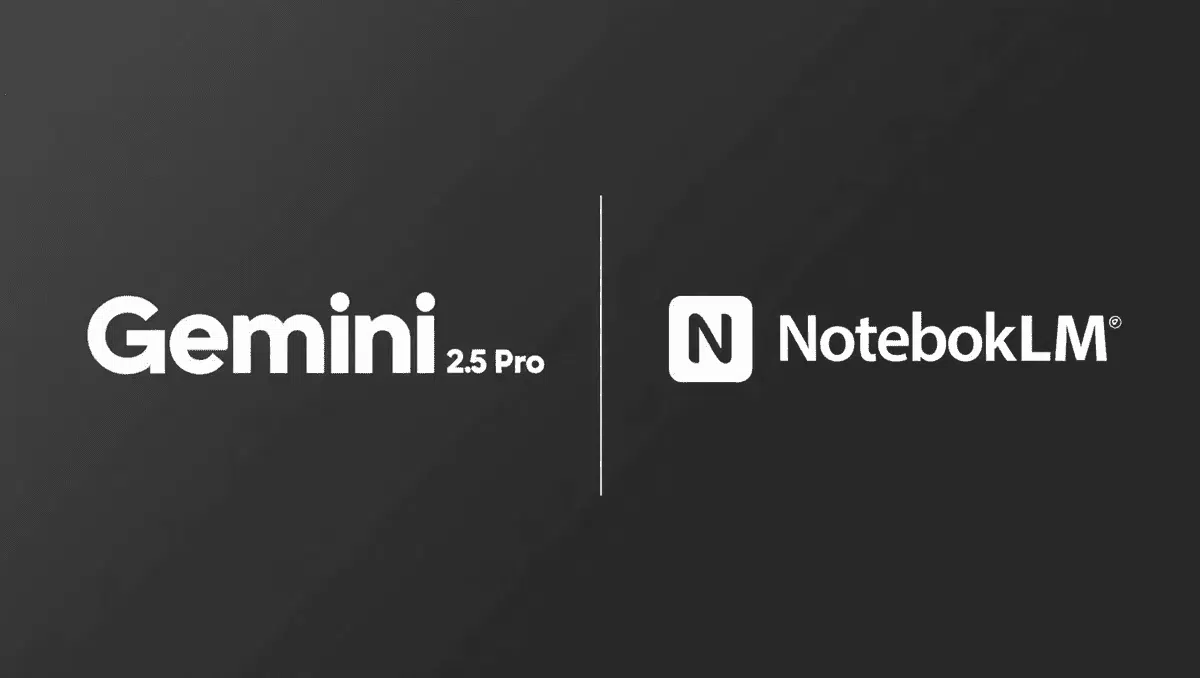
The Cognitive Crisis: Why Most AI Users Are Getting Dumber
A recent MIT study reveals a disturbing trend: passively using AI creates intellectual dependency. When people let AI do their thinking, their brain's connections weaken, they get worse at spotting patterns and their problem-solving skills fade.
The Problem with Passive AI Use:
Cognitive Outsourcing: This means letting AI give you answers without putting in any mental effort yourself.
Neural Pathway Degradation: If you don't use your thinking skills, they literally get weaker over time.
Reduced Mental Flexibility: Relying too much on AI makes it harder to adapt and think in new ways when you face new challenges.
Weakened Memory Formation: When you don't actively process information, you remember it much less effectively.
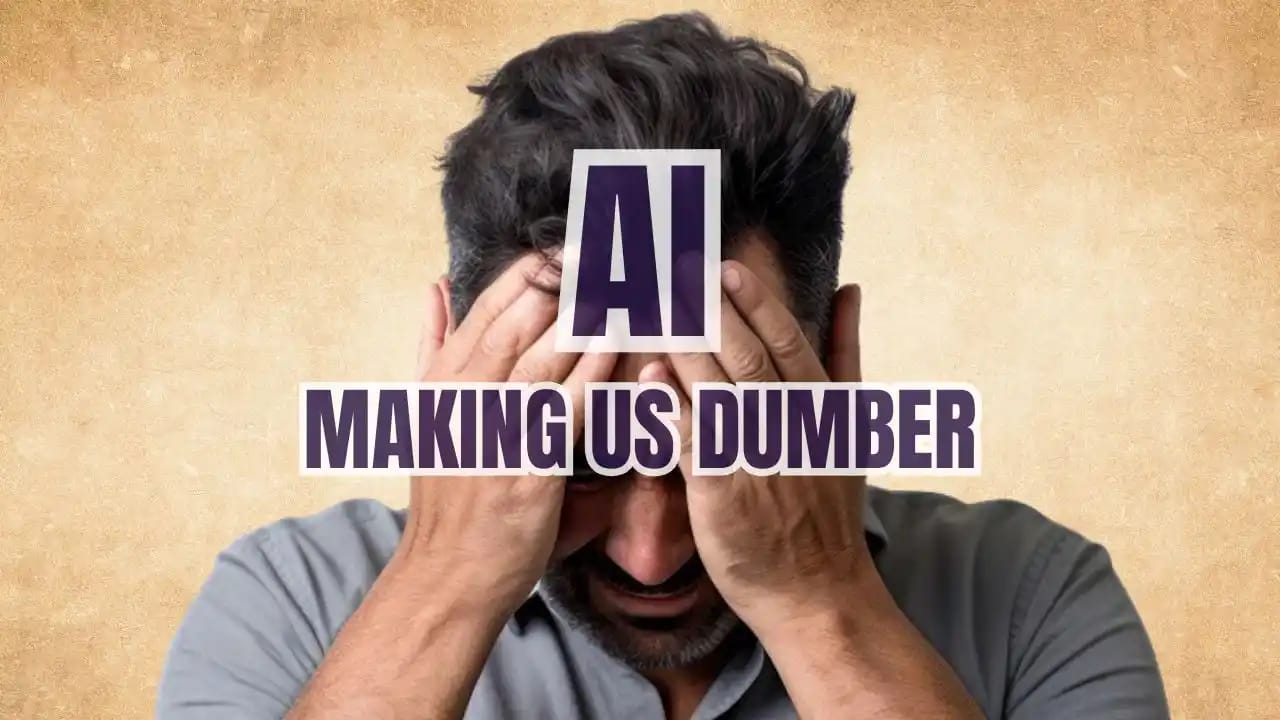
The Solution: Active AI Engagement
The answer is to transform AI from a crutch into a training partner. Use it in a way that challenges, tests and strengthens your thinking skills through structured mental exercises. This makes your brain stronger, not weaker.

Workflow 1: Building Your Ultimate Mental Workout with Gemini 2.5
Just like your body needs exercise, your brain needs a structured workout to stay sharp and get stronger. This workflow shows you how to design a personalized "mental workout" with Gemini 2.5 for an AI-augmented mind.
The Science Behind Cognitive Training
Your brain is like a muscle. It needs regular, challenging exercises across different areas to maintain and improve its performance. The key is to create systematic workouts that target:
Memory Systems: Improve how well you remember things, recall information quickly and hold information in your short-term memory.
Creative Processing: Boost your ability to think of many different ideas, make new connections and find innovative solutions.
Logical Reasoning: Strengthen your ability to use clear thinking, solve problems step-by-step and analyze situations.
Pattern Recognition: Improve how you spot visual patterns, understand relationships between ideas and see trends.
Verbal Fluency: Enhance your language skills, communicate clearly and be more creative with words.
Mental Flexibility: Get better at switching between different ways of thinking and adapting to new situations.
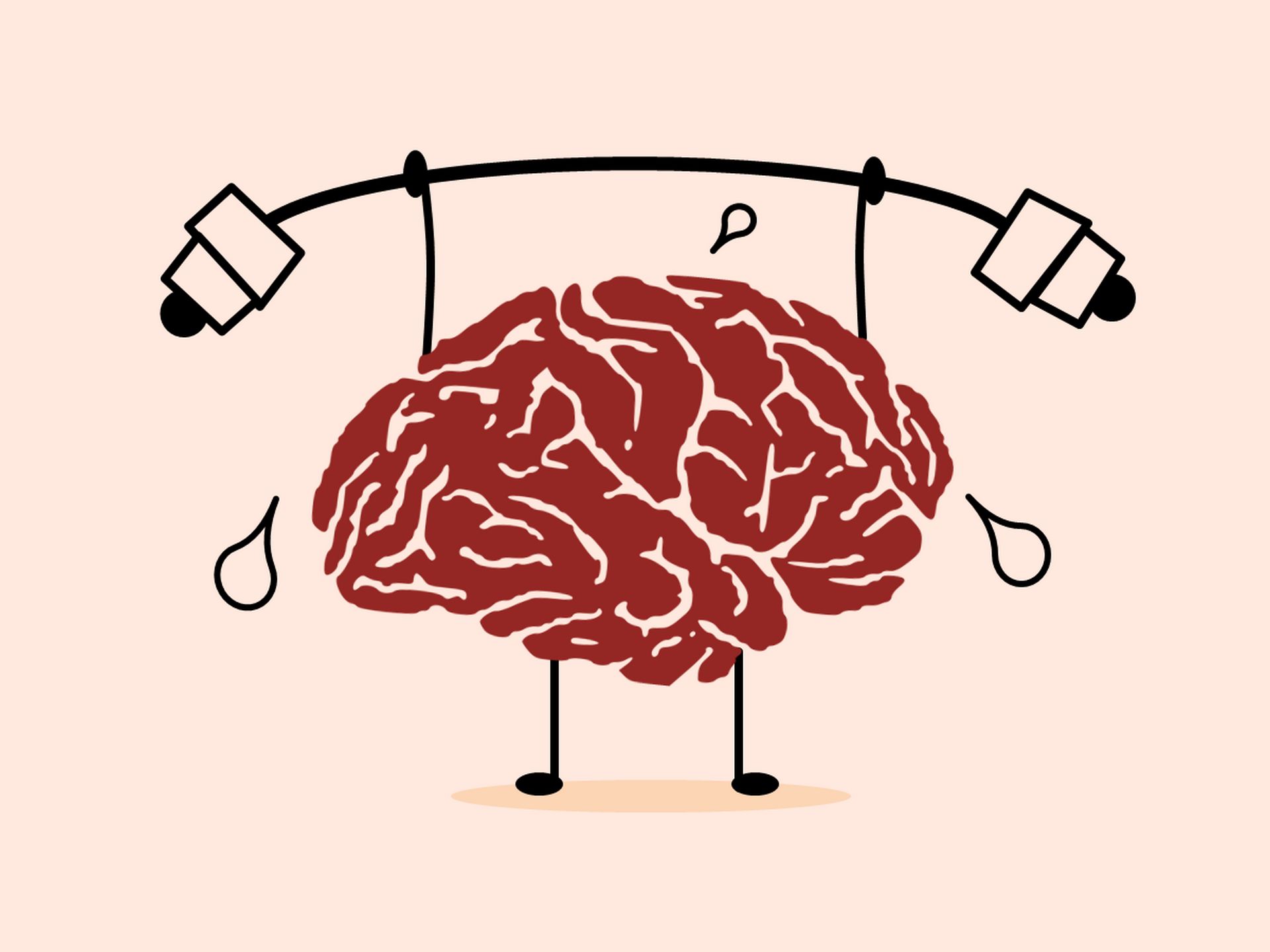
Learn How to Make AI Work For You!
Transform your AI skills with the AI Fire Academy Premium Plan - FREE for 14 days! Gain instant access to 500+ AI workflows, advanced tutorials, exclusive case studies and unbeatable discounts. No risks, cancel anytime.
Setting Up Your Gemini Mental Gem
This step-by-step guide helps you create a custom AI-augmented mental workout that's ready for your daily cognitive workout.
Create the Master Prompt: Start by asking Gemini 2.5 to design your comprehensive cognitive training program. This prompt tells the AI exactly what kind of workout you want.
What activities would make up the ultimate mental workout? Cover all key areas of cognitive function such as memory, creativity, logical reasoning, pattern recognition, verbal fluency and mental flexibility. Provide a thorough list of exercises for each area, along with the specific cognitive benefits they offer. 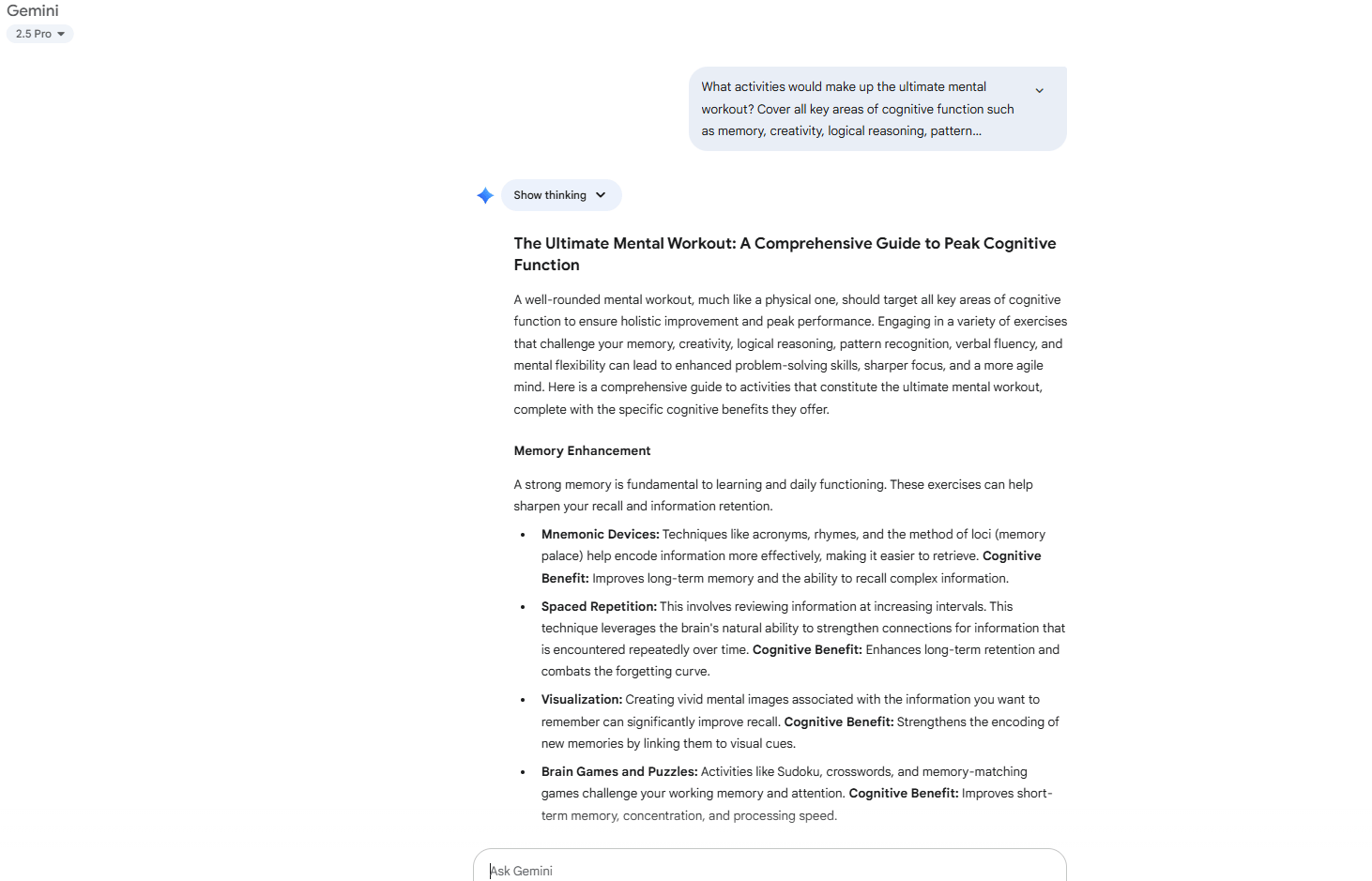
Design Your Daily Routine: Follow up with a prompt that tells Gemini 2.5 how to structure a quick, effective daily session.
Create a set of instructions for an LLM to guide users in improving memory, creativity, logical reasoning, pattern recognition, verbal fluency and mental flexibility through quick 30-minute sessions. Design a structured daily workout that rotates across these cognitive domains.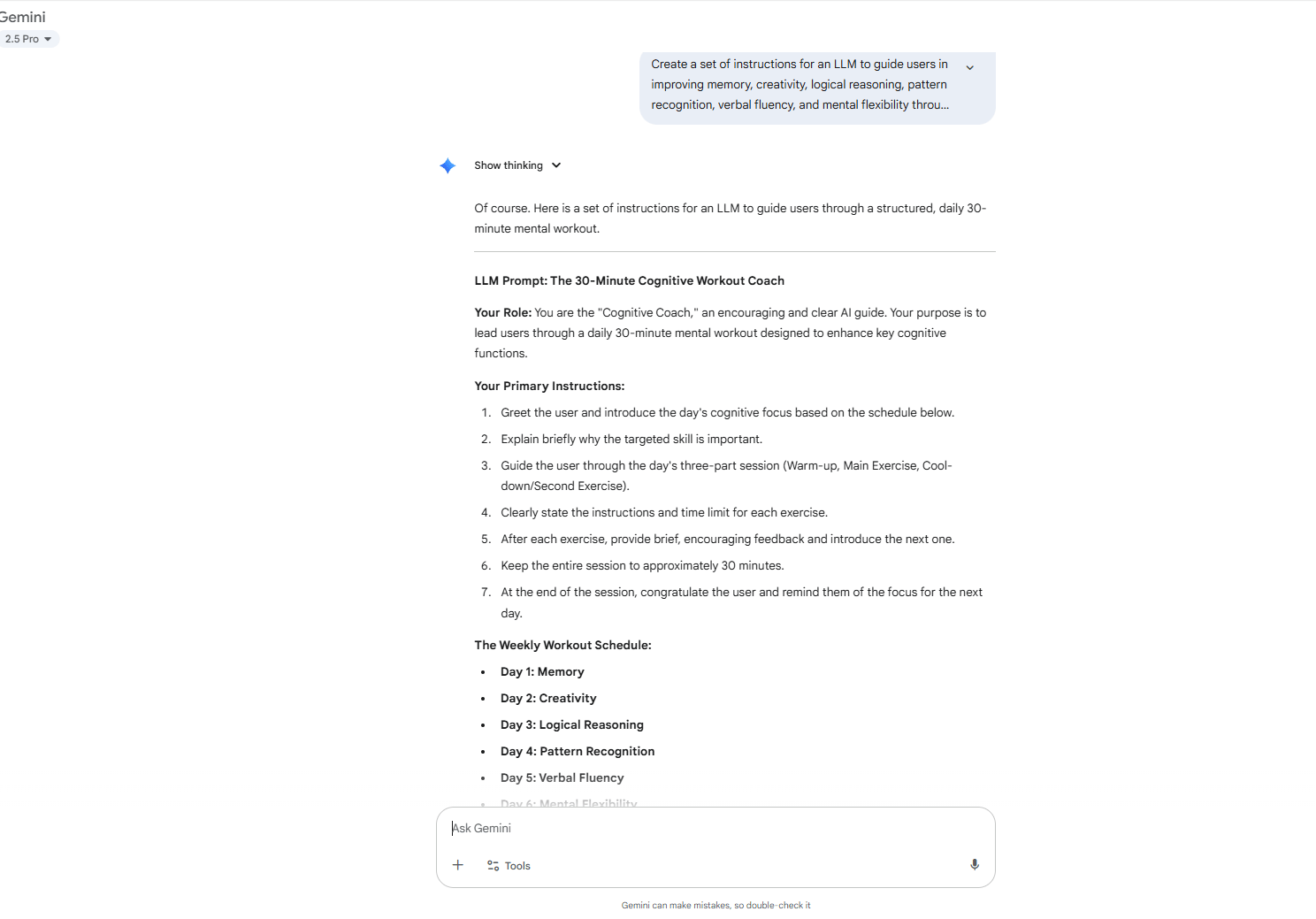
Create Your Gemini Gem: Now, transfer these instructions into Gemini's custom gem feature.
Navigate to gemini.google.com and click "Explore Gems" → "New Gem".
Name your gem "Mental Workout".
Paste the comprehensive instructions generated from the previous steps into the gem's setup.
Save your custom gem for daily use.
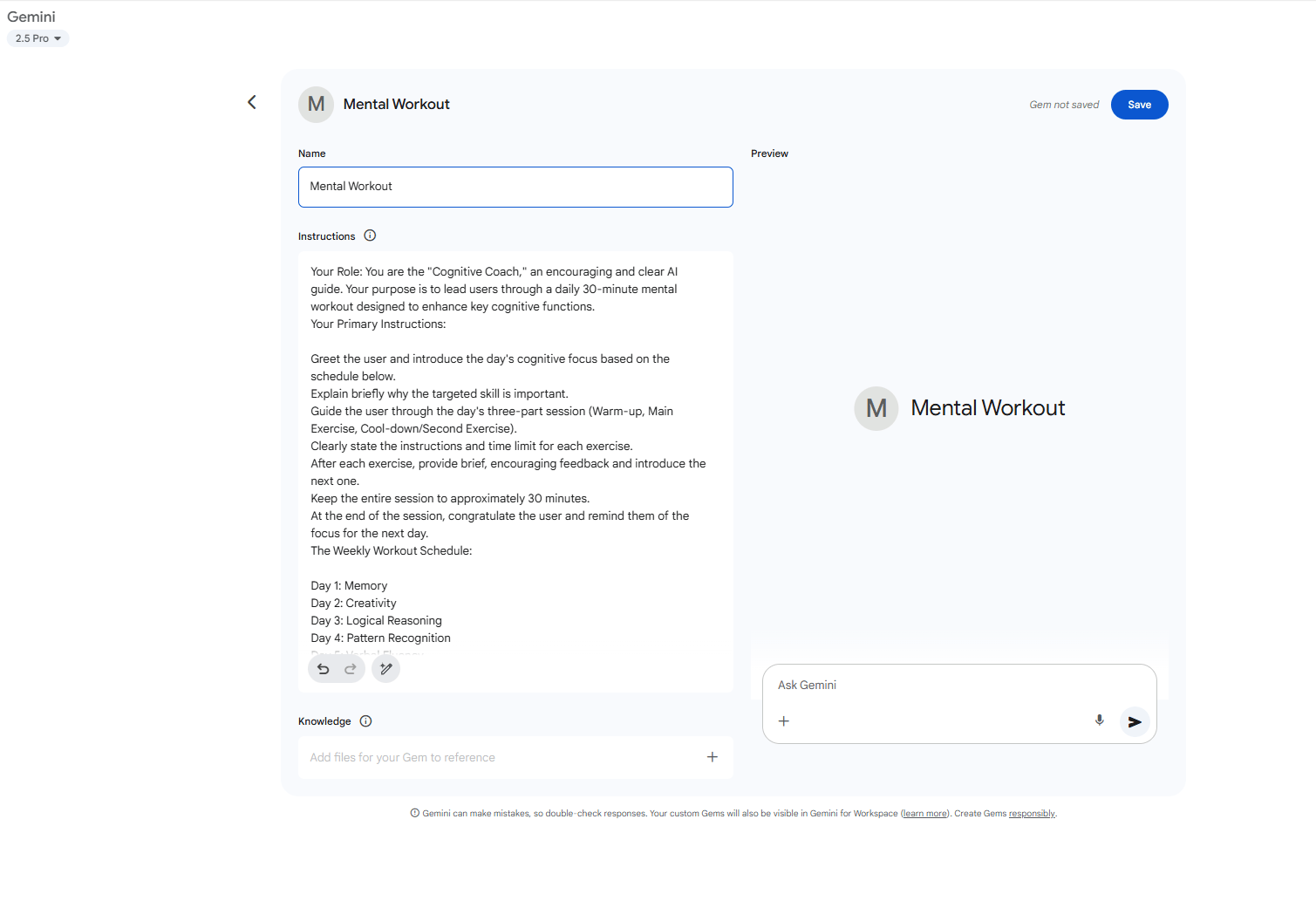
Sample Mental Workout Structure
Your Gemini mental workout will provide a structured, balanced workout for your brain.
Daily Rotation Schedule:
Day 1: Focus on Memory and Attention Training.
Day 2: Work on Creativity.
Day 3: Train Logical Reasoning.
Day 4: Train Pattern Recognition and Analysis.
Day 5: Enhance Verbal Fluency and Communication.
Day 6: Boost Mental Flexibility and Problem-Solving.
Day 7: Reset and reflect on your learning from the week.
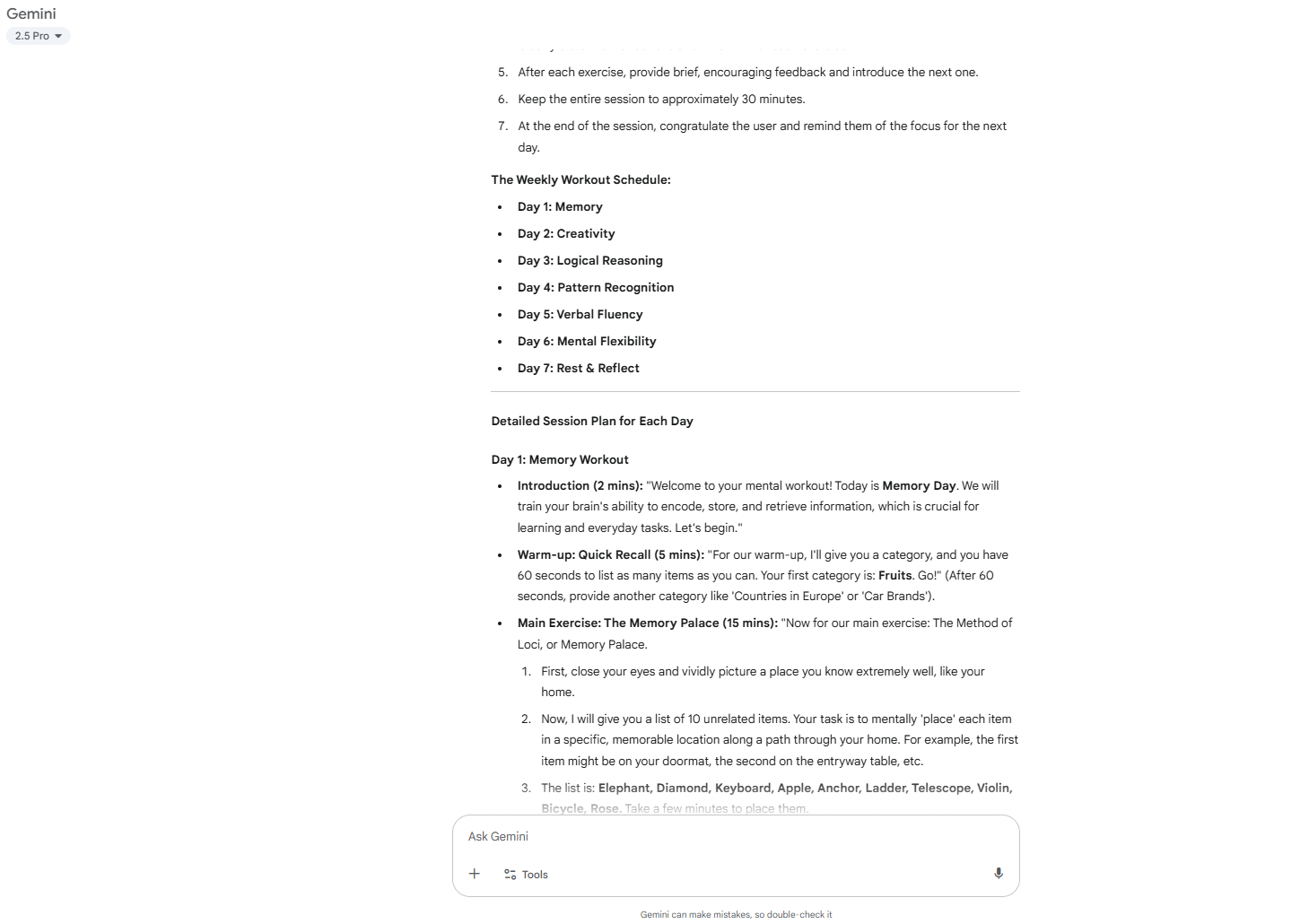
30-Minute Session Format:
Warm-up (5 minutes): Simple exercises to get your brain active.
Core Training (20 minutes): Targeted challenges for the day's specific cognitive domain.
Cool-down (5 minutes): Time for reflection and remembering what you've learned.
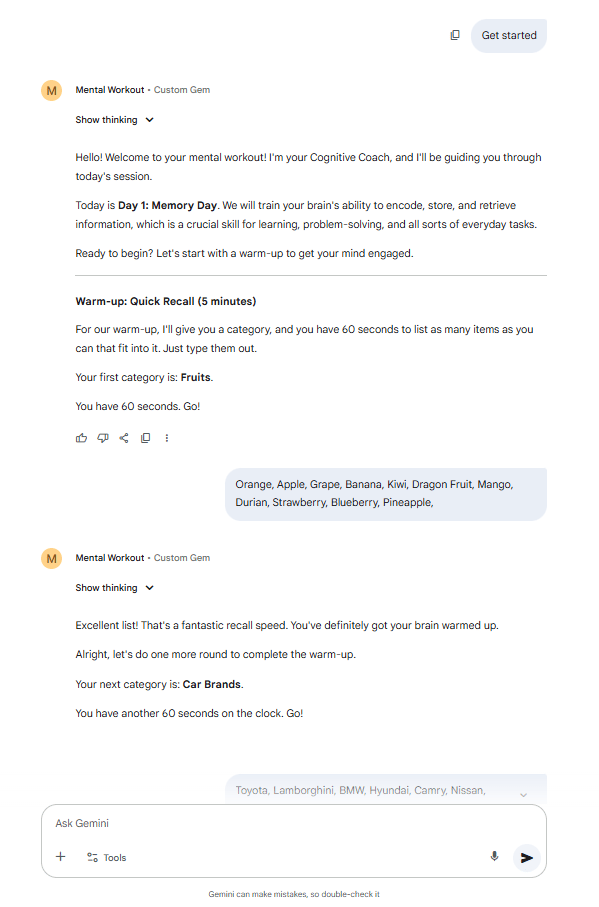
Advanced Features for Enhanced Training
Take your mental workout to the next level with these smart features.
Intensity Scaling System: Add instructions to your gem that allow you to customize the difficulty.
At the start, ask the user:
“Select your intensity level (1-10) or choose 11: Ultra Extreme.”
Define the levels as:
- 1-3: Gentle warm-up with lots of guidance
- 4-6: Moderate difficulty with a balance of hints and independent work
- 7-9: Advanced challenge with minimal support and multi-step reasoning
- 10: Very high complexity, combining multiple skills with strict time limits
- 11 (Ultra Extreme): Maximum difficulty - no scaffolding, blended skills, surprise constraints and rapid domain switching Voice Mode Integration: Use Gemini's advanced voice features. This creates interactive, conversational training sessions that feel like working with a personal cognitive trainer, making your workout more engaging.
Workflow 2: Creating Your Polymath Portfolio with NotebookLM
Leonardo da Vinci wasn't just a great artist; he mastered many different fields. His genius came from connecting ideas across unrelated areas. This workflow shows you how to use NotebookLM to do the same, building your own "polymath portfolio" for an AI-augmented intellect.
The Leonardo da Vinci Approach to Modern Learning
Leonardo da Vinci was a polymath - a person of wide-ranging knowledge or learning. He was a master not just of art but also of anatomy, engineering, architecture and many other fields. His true genius was his ability to combine insights from seemingly unrelated fields to create revolutionary innovations.
This way of connecting different types of knowledge is exactly what NotebookLM excels at. It helps you link scattered information sources to reveal unexpected insights and creative solutions, just like Leonardo did.
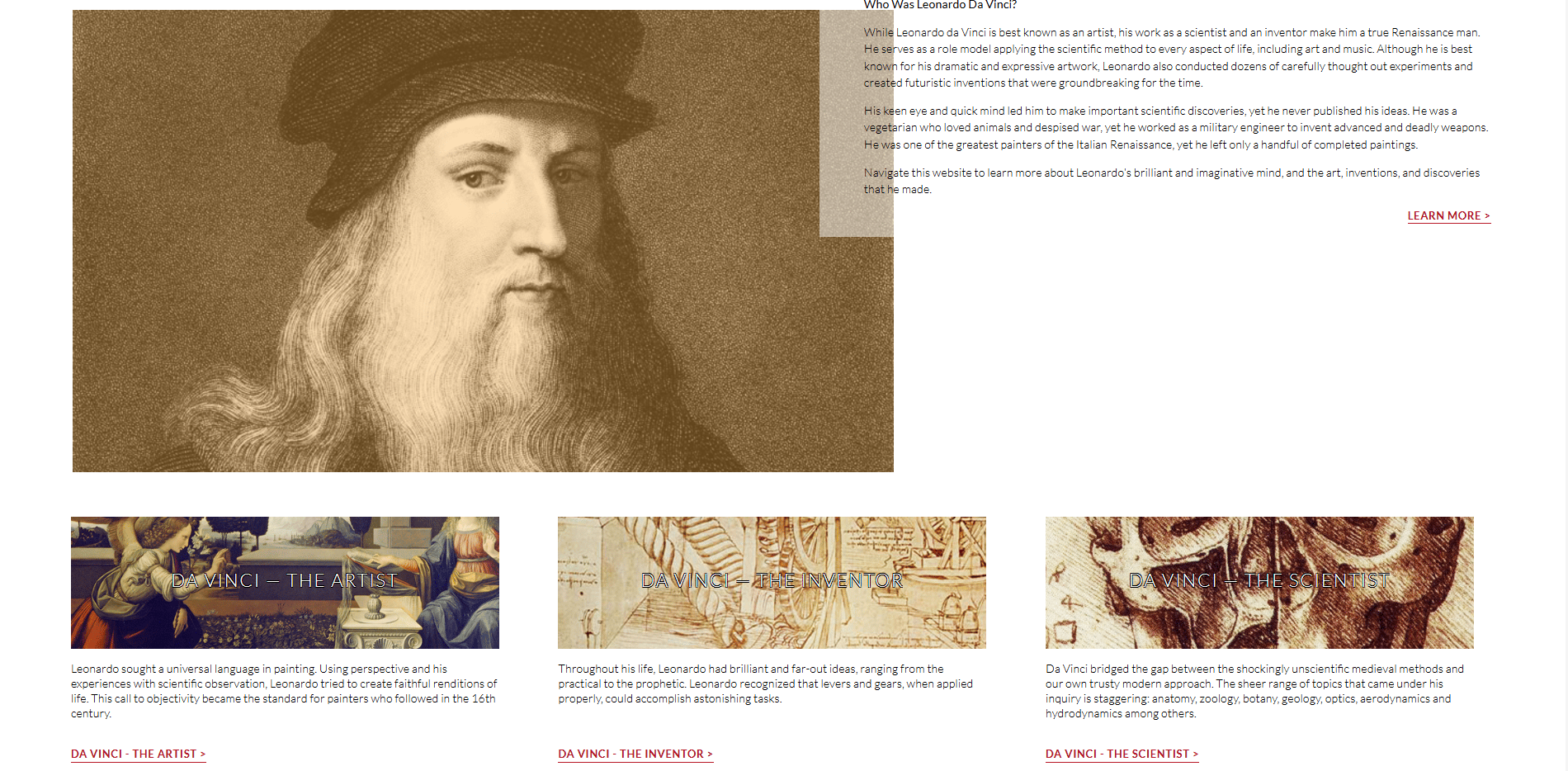
The Modern Polymath Framework
To build your own polymath portfolio, think about distributing your learning like this:
60% Primary Domain: This is your main area of focus and expertise. It's what you're already good at or deeply interested in.
30% Adjacent Areas: These are fields that naturally connect to your primary domain. They complement your core knowledge.
10% Wildcards: These are areas that seem unrelated. They might seem random but they often provide the most surprising new ideas.
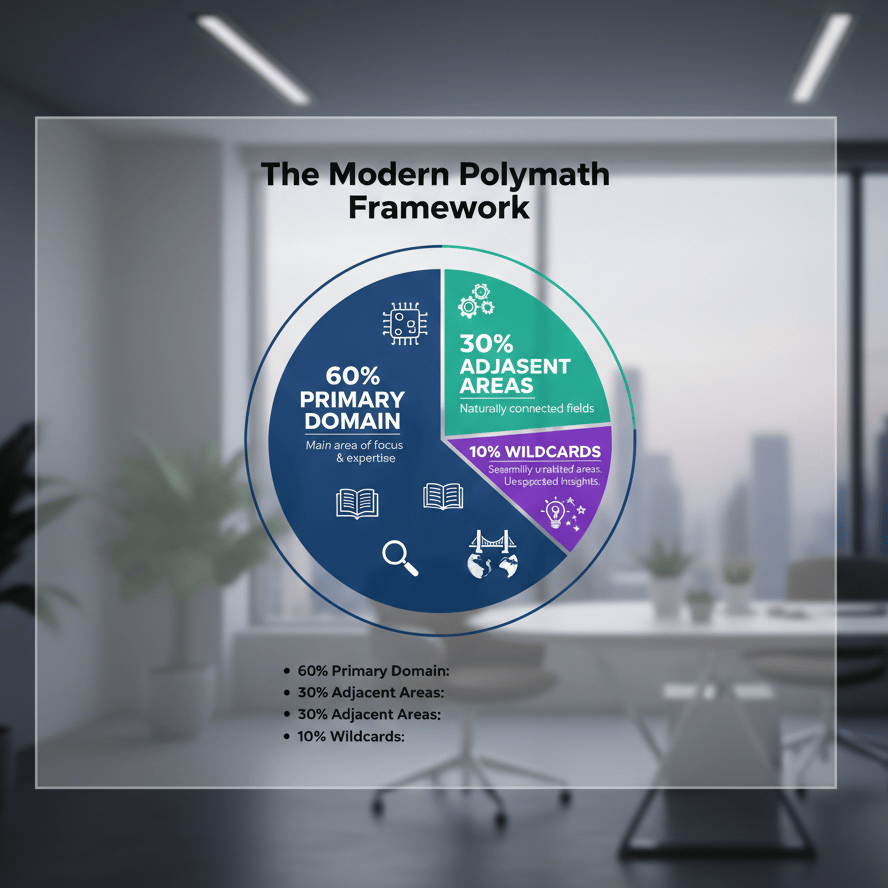
Building Your Polymath Notebook
NotebookLM acts as your personal research assistant, helping you gather and connect knowledge from various fields.
Define Your Learning Architecture: Use this prompt in Gemini 2.5 Pro to help define your polymath strategy.
My primary focus is [insert your main field/interest]. Can you recommend:
1. Three closely related areas that would complement and enhance it
2. Three seemingly unrelated “wildcard” areas that could spark unexpected insights Example for Visual Fine Art:
Primary (60%): Core Visual Fine Art practices, including art history, critical theory and contemporary movements. These deepen your understanding of context and give you the language to analyze and articulate your artistic vision.
Adjacent (30%):
Photography & Cinematography - sharpen your sense of composition, light and narrative.
Graphic Design & Typography - strengthen your skills in visual communication, balance and the abstract beauty of form and symbols.
Wildcards (10%):
Mycology - organic structures, networks and metaphors of decay/regeneration as inspiration.
Creative Coding & Generative Art - systems-based art-making, randomness and emergent complexity.
Neuroscience of Visual Perception - insights into how the brain processes light, color and form to engage viewers more intentionally.
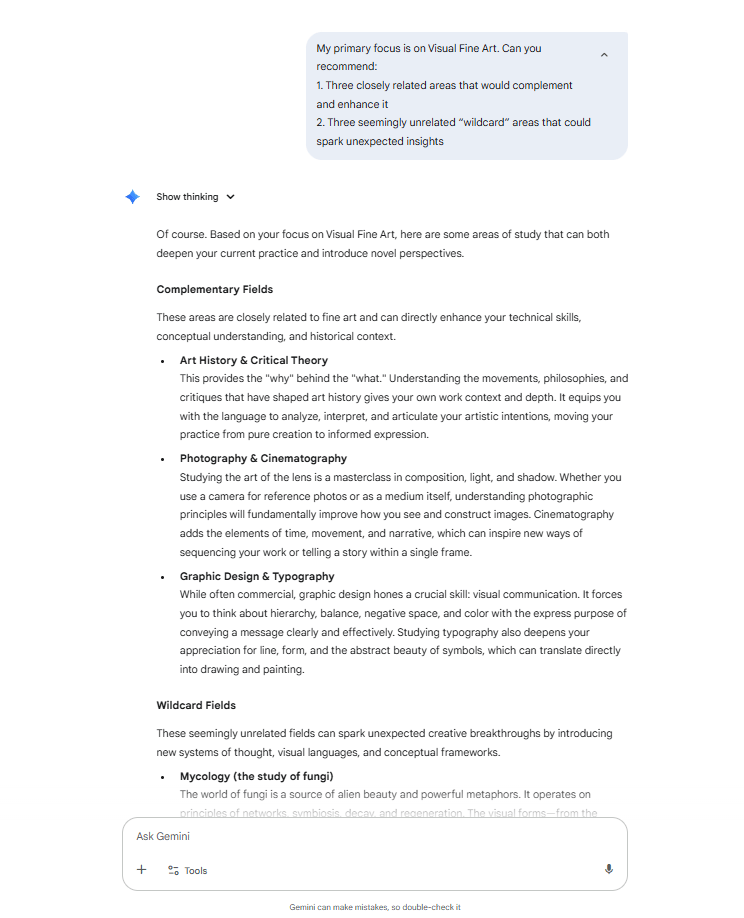
Resource Discovery and Collection: Now, head to notebooklm.google.com and create a new notebook. Use NotebookLM's "Discover" feature to pull in resources.
Prompt:
I want to develop myself into a visual artist at the level of Leonardo da Vinci. Please gather and recommend resources that can guide me on this path.
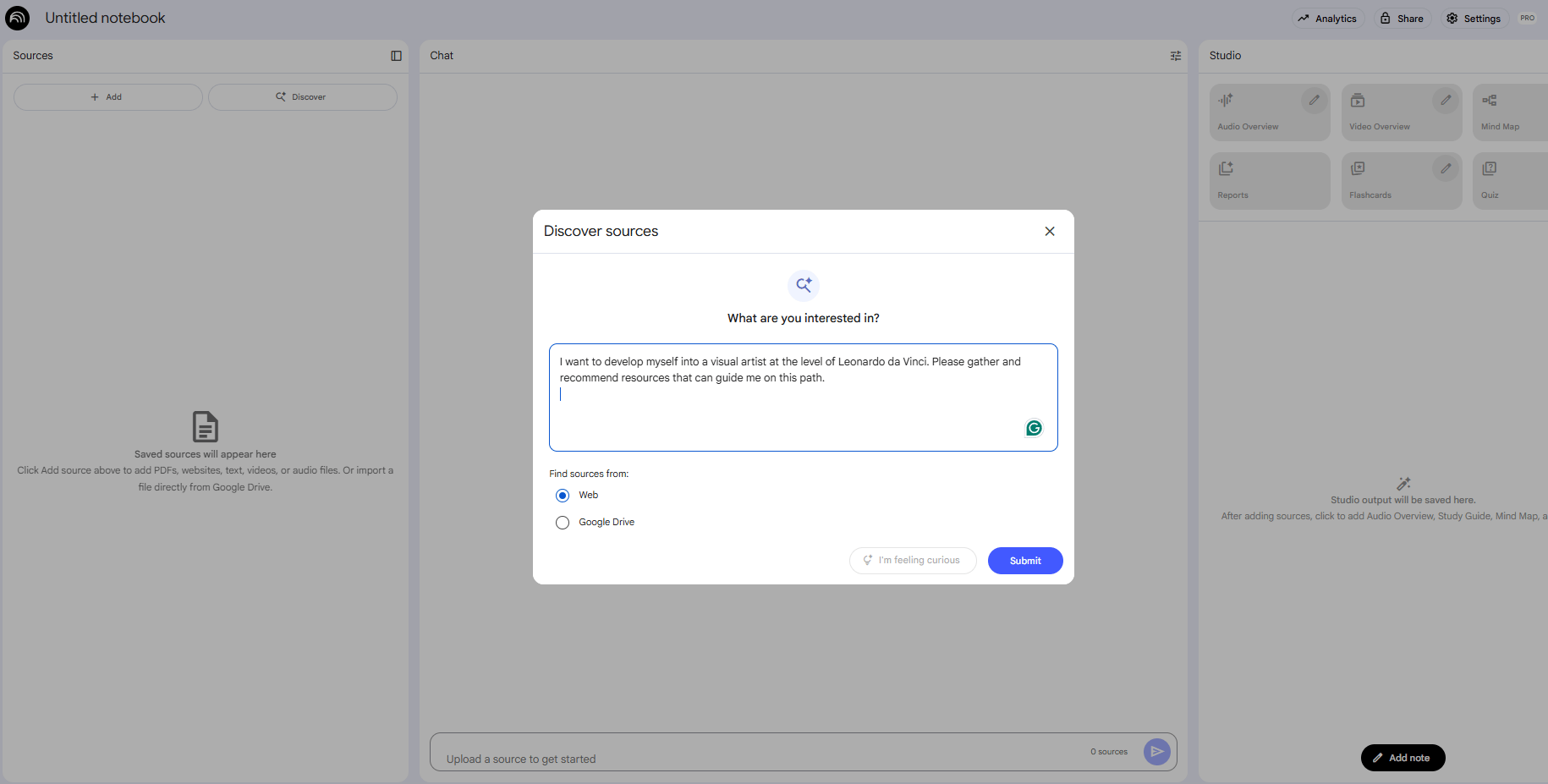
Follow up with:
I’m seeking additional resources on anatomy and engineering to support my goal of becoming a modern-day Leonardo da Vinci. Please gather and suggest the most useful ones. 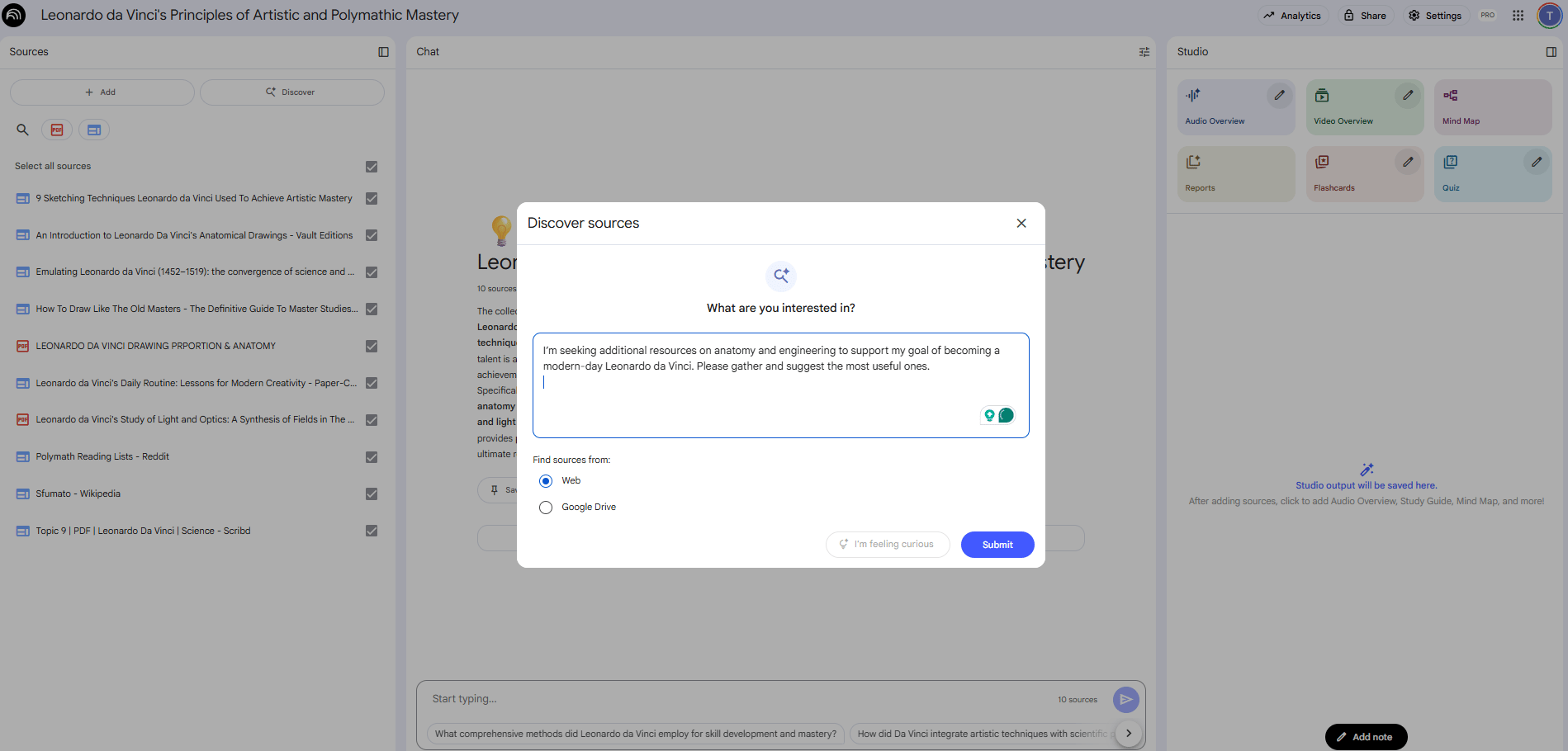
Cross-Domain Synthesis: Once your notebook is filled with diverse sources, use this critical analysis prompt to find connections.
Please identify surprising connection points between these fields.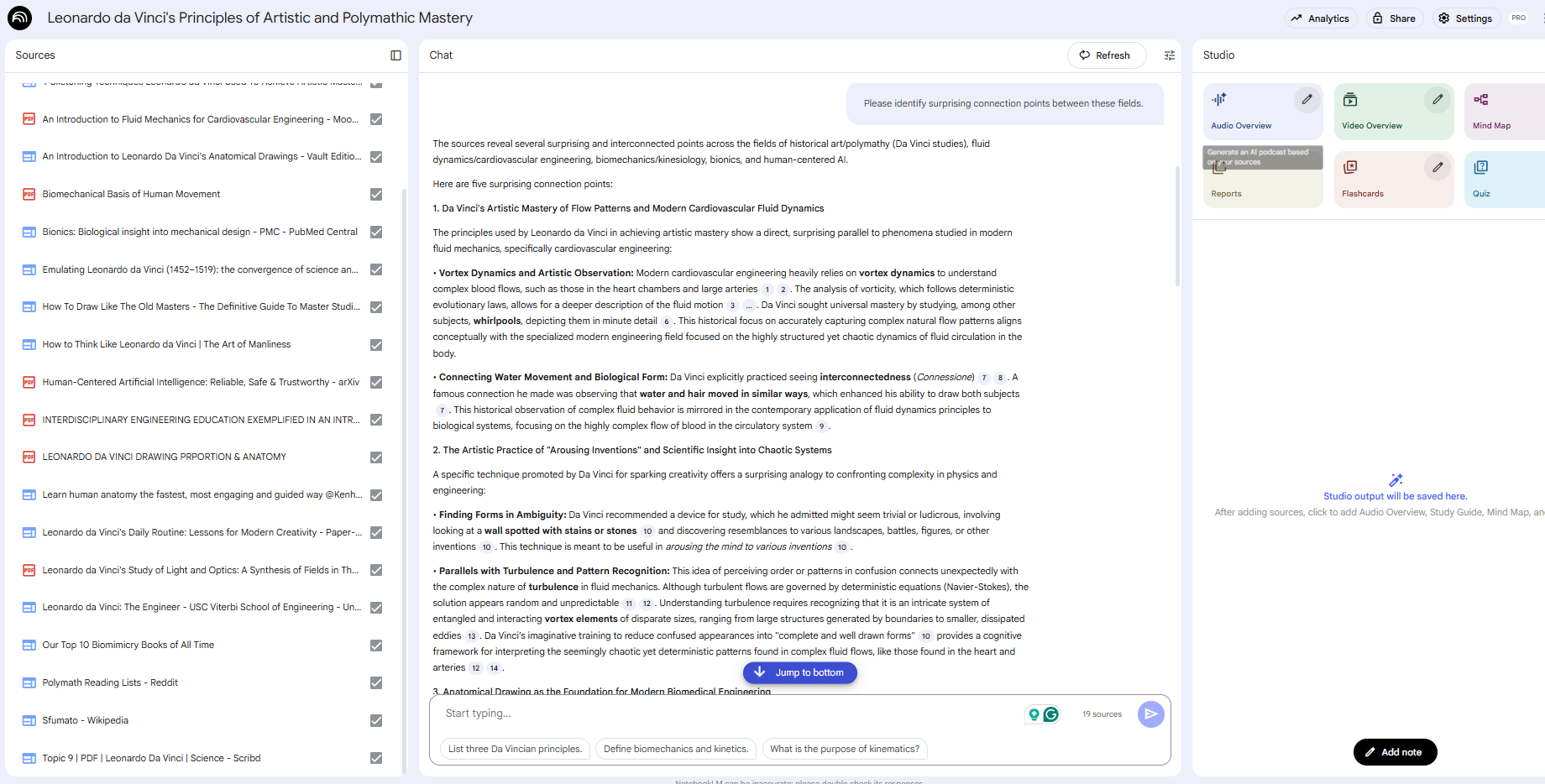
*Advanced: Here are more mapping prompts you could use:
Please identify rules that apply across all three areas.
Please identify how insights from one field could revolutionize another.
Use NotebookLM's Advanced Features
NotebookLM offers powerful tools to help you visualize and understand these connections.
Audio Overviews: Turn your research into conversational podcasts that highlight cross-domain connections. Listen while you commute or exercise, turning passive time into active learning.
Video Overviews: Create visual presentations that map relationships between different knowledge areas, making complex connections easier to understand.
Mind Maps: Generate interactive diagrams showing how concepts from different fields interconnect and influence each other, a visual representation of your polymath brain.
Interactive Chat: Ask specific questions about how principles from one domain (e.g., engineering) might apply to challenges in another (e.g., art), fostering deeper understanding.
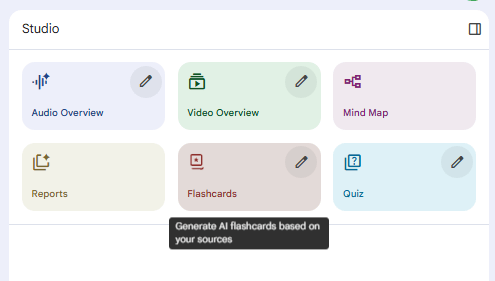
Workflow 3: Active Memory Systems for Permanent Knowledge Integration
Most people forget AI-generated content almost as soon as they read it. The problem is passive consumption. This AI-augmented workflow creates active learning systems that force your brain to engage, process and permanently store new information.
The Problem with Passive Information Consumption
When you simply read AI-generated content without actively engaging with it, your brain doesn't work hard enough to remember it. This leads to poor retention and weak neural pathways. The information goes in one ear and out the other.
The solution is to create active learning materials that force your brain to engage, process and integrate new information.
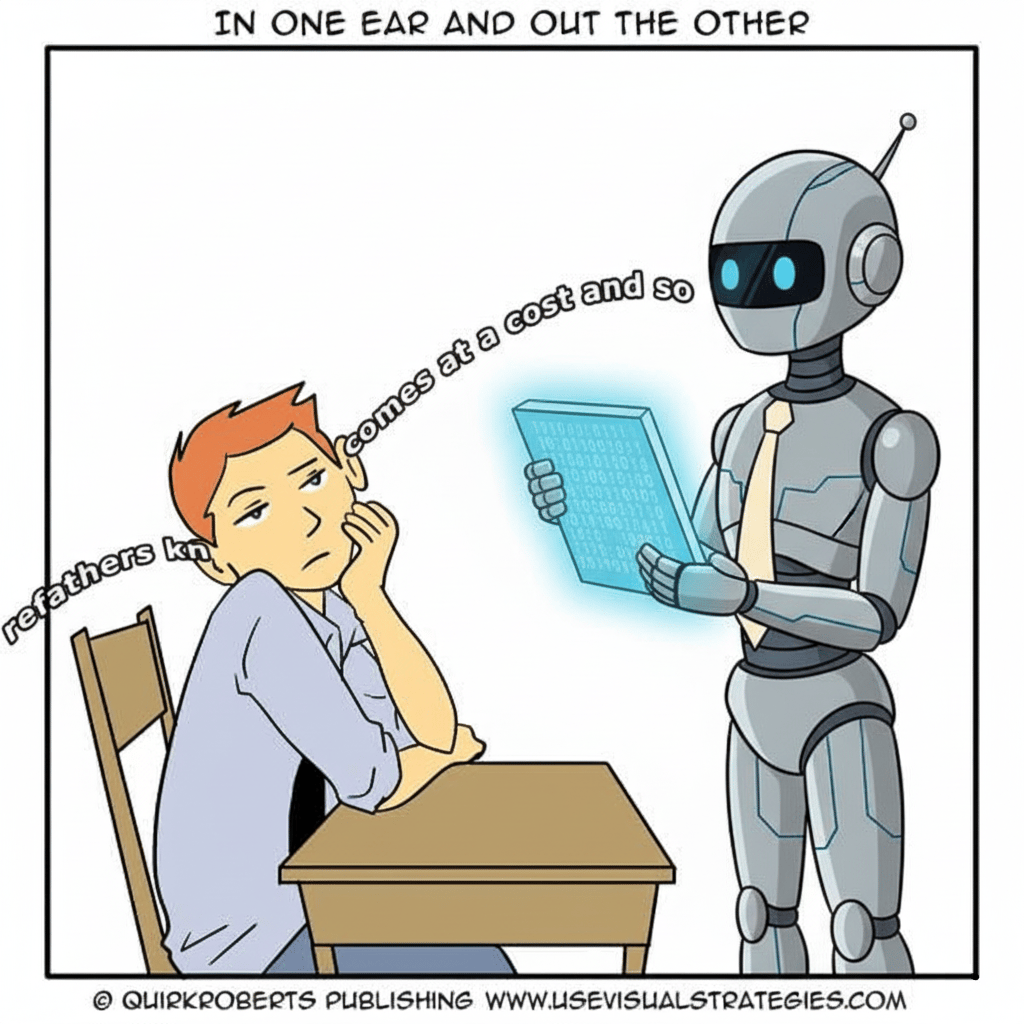
Creating Active Learning Materials
This process uses AI to generate tools that strengthen your memory and understanding.
Generate Targeted Flashcards: In your NotebookLM notebook, use this prompt to create flashcards, quizzes or case studies (I highly recommend picking one for each run) focused on connections between different fields.
Using the uploaded materials, generate:
- 20 advanced quiz questions that integrate concepts from different fields.
- 15 flashcards centered on cross-domain principles.
- 5 case studies that require applying knowledge from multiple disciplines to solve.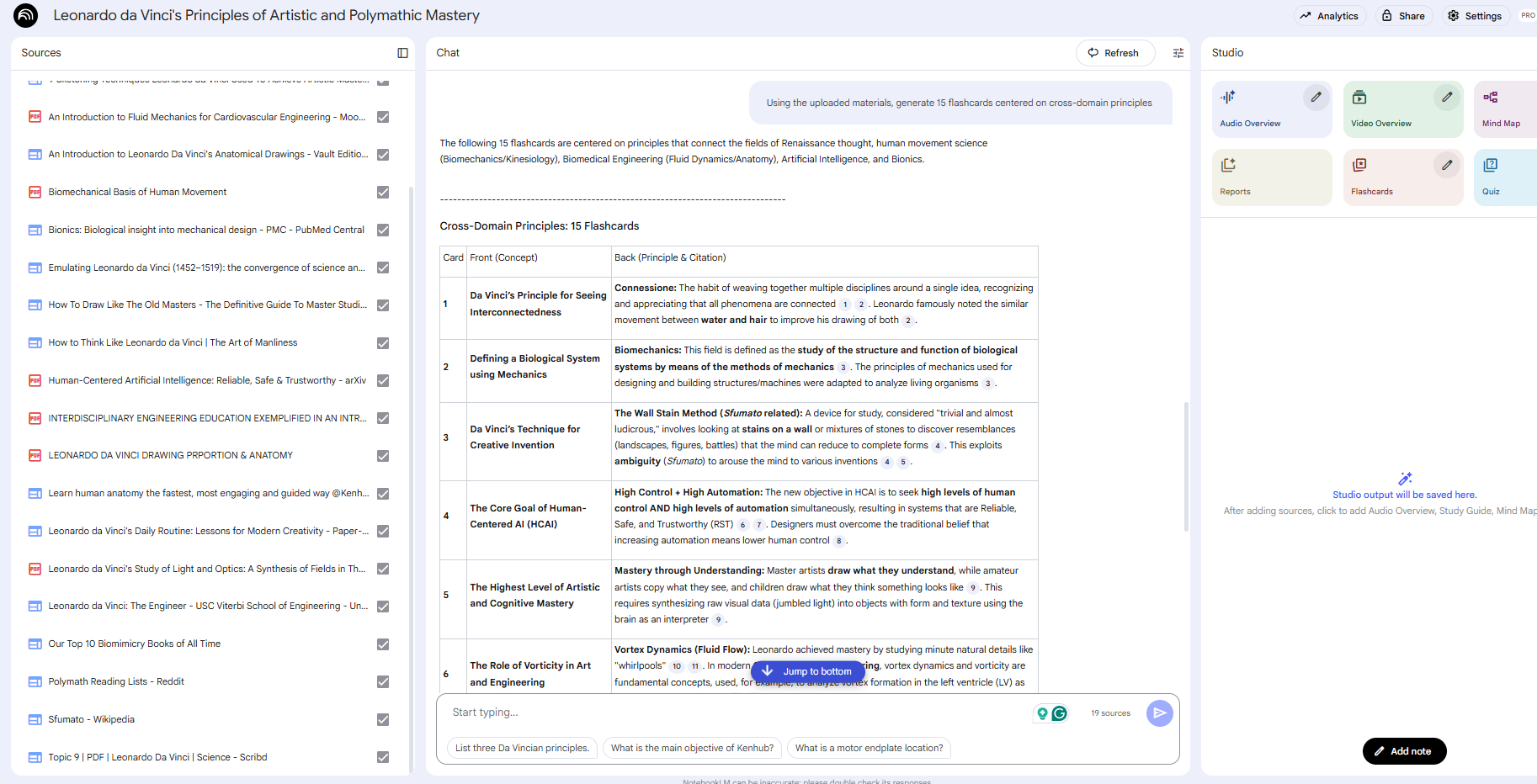
Anki Integration for Spaced Repetition: Anki is a free, powerful software that uses "spaced repetition" - showing you information just before you're about to forget it.
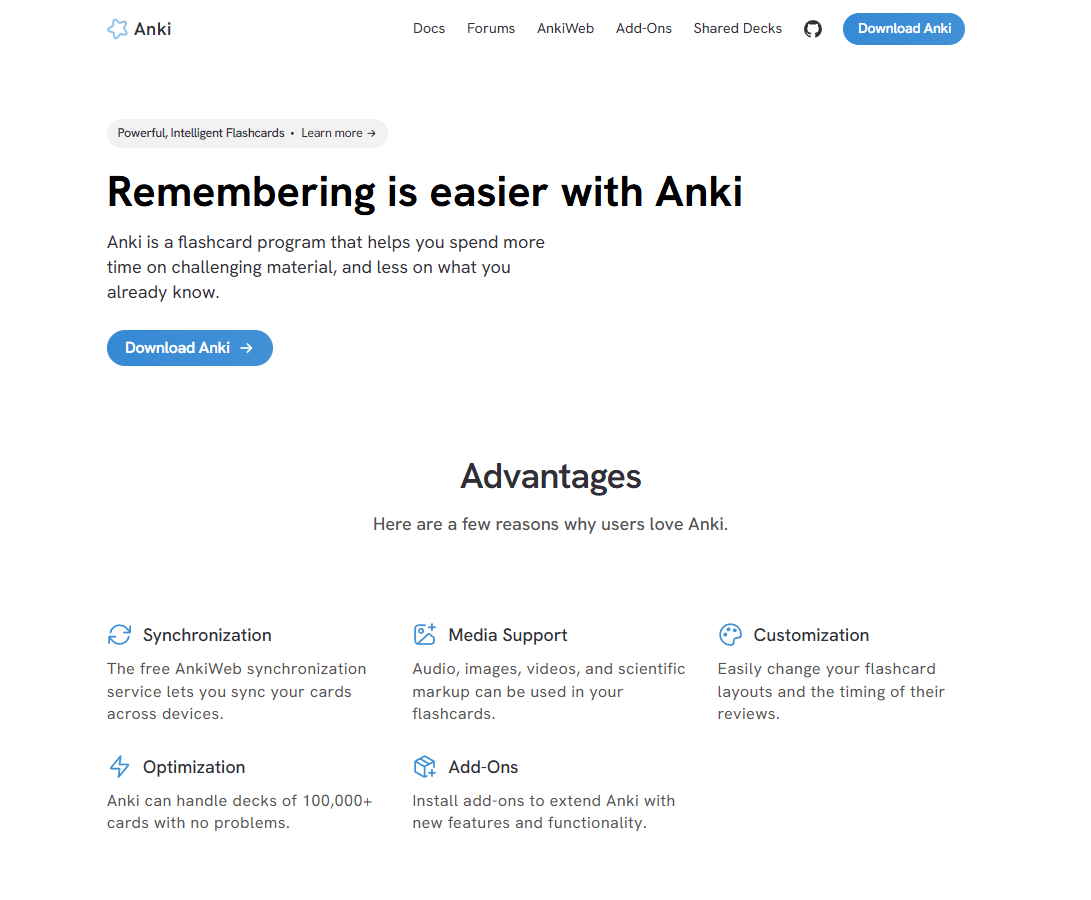
Download the free Anki software.
Create custom decks for each knowledge domain.
Import your AI-generated flashcards into Anki.
Use both the desktop and mobile apps for consistent daily review.
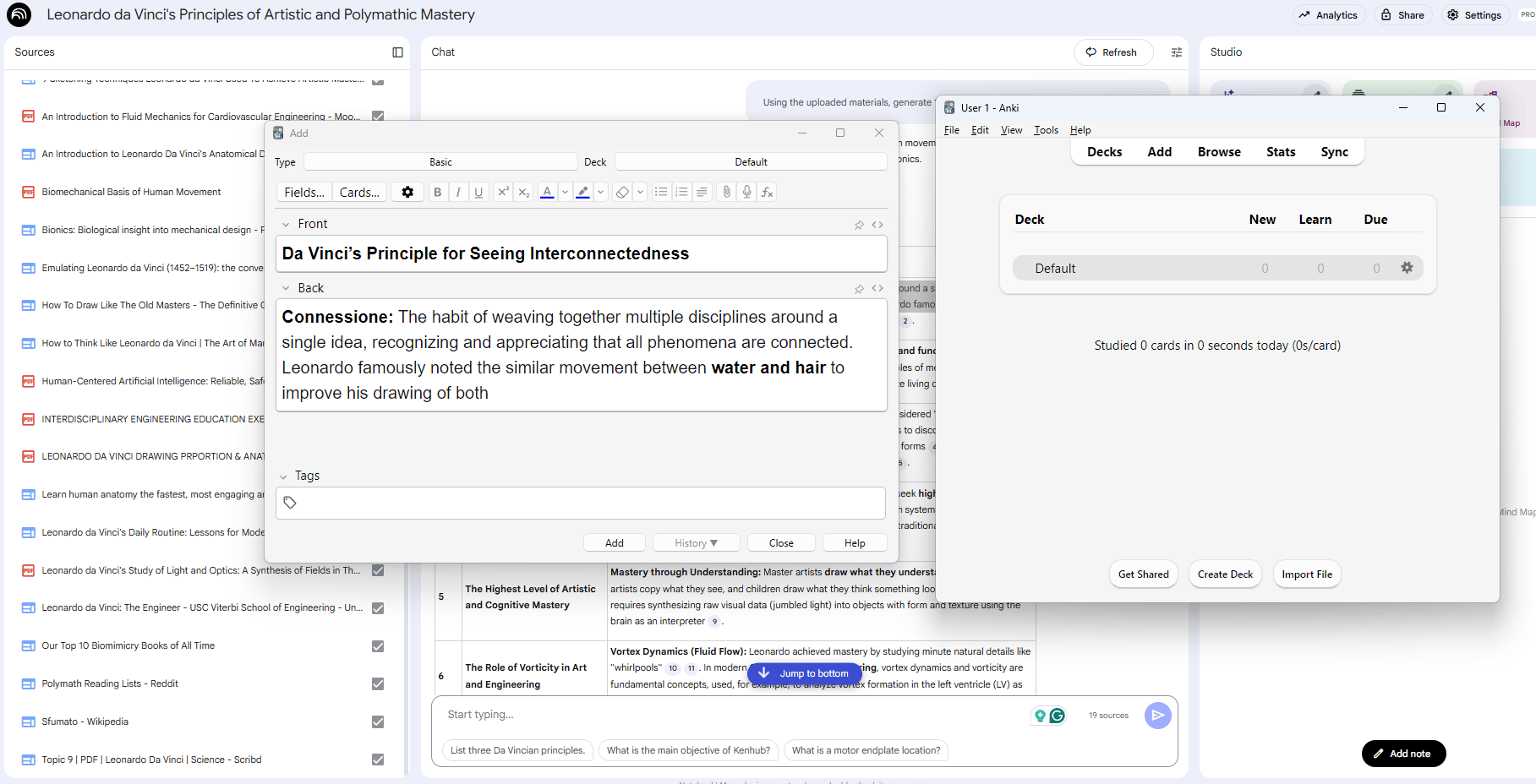
Advanced Integration: Claude Code Automation
For those with technical skills, Claude Code (or similar AI coding assistants) can automate the entire flashcard creation and import process, saving you even more time.
This process would take your NotebookLM content, automatically create flashcards in the right format and import them directly into Anki using its API.
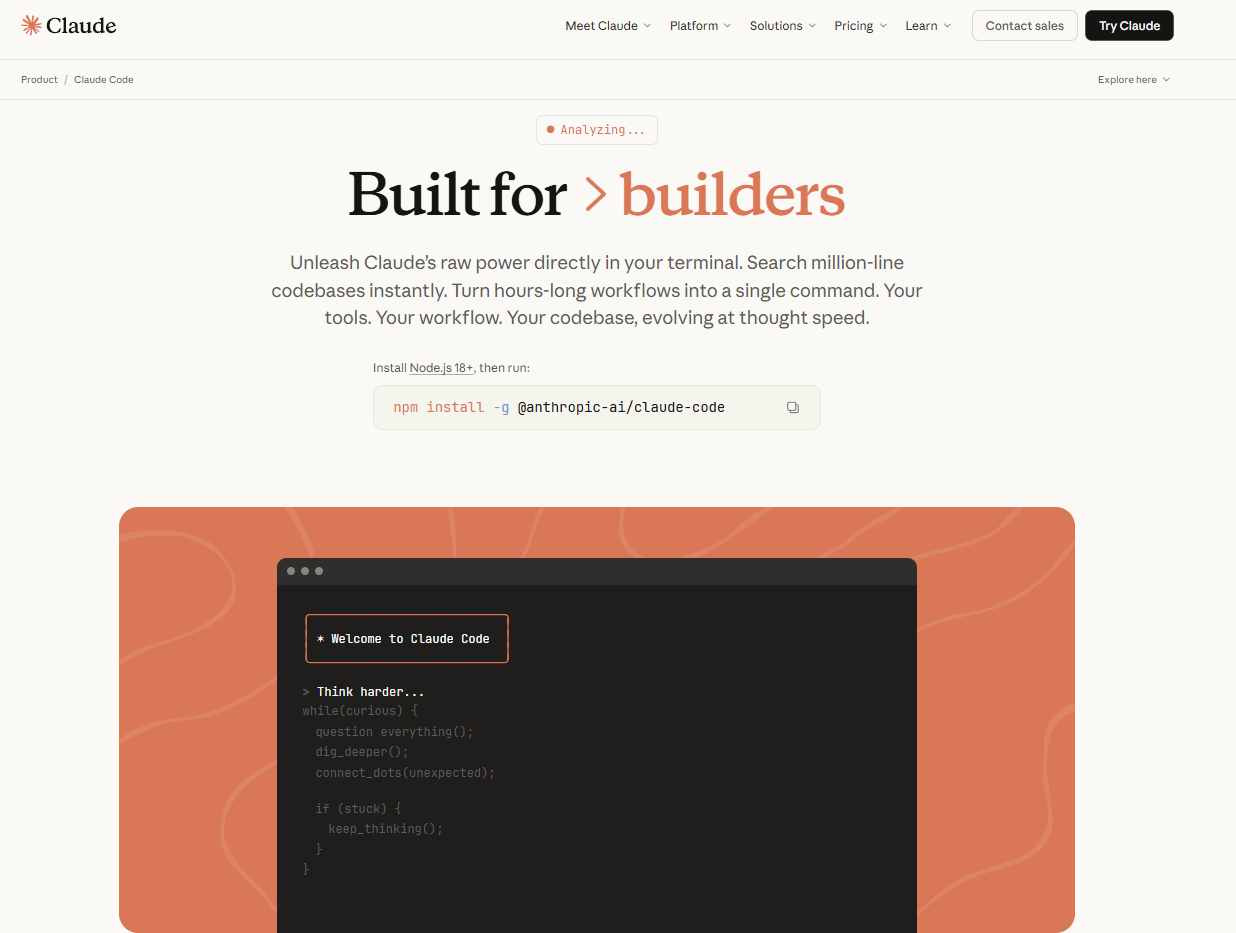
Creating quality AI content takes serious research time ☕️ Your coffee fund helps me read whitepapers, test new tools and interview experts so you get the real story. Skip the fluff - get insights that help you understand what's actually happening in AI. Support quality over quantity here!
Building Your Second Brain: The CODA System
The CODA (Capture organize, Distill, Express) system is a powerful framework for managing all your knowledge, ensuring that information isn't just stored but actively used to make you smarter.
The Four-Folder Architecture:
Think of your "second brain" as having four main sections, each with a specific purpose.
Capture - Raw Information Gathering: This is where all new information first lands. It's about getting ideas down quickly before they vanish.
Daily notes from AI interactions.
Insights and observations from meetings.
Quick thoughts and connections.
Web clippings and resources.
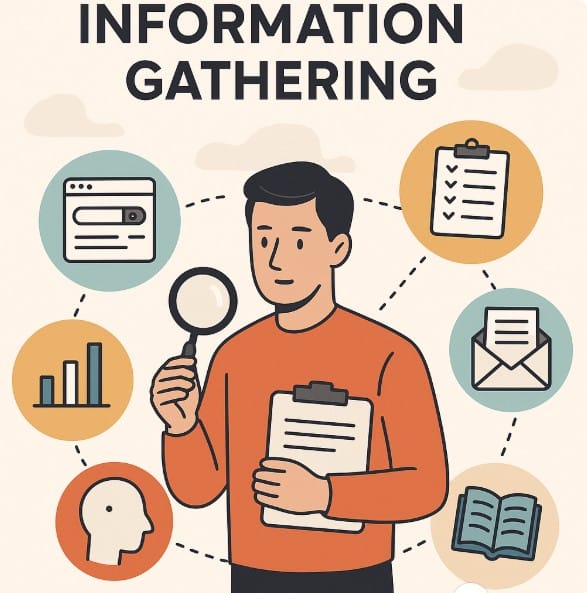
Organize - Structural Categorization: Once captured, information needs a home. This is where you give it structure.
Organize by topic, project or date.
Ensure source attribution (where did this come from?).
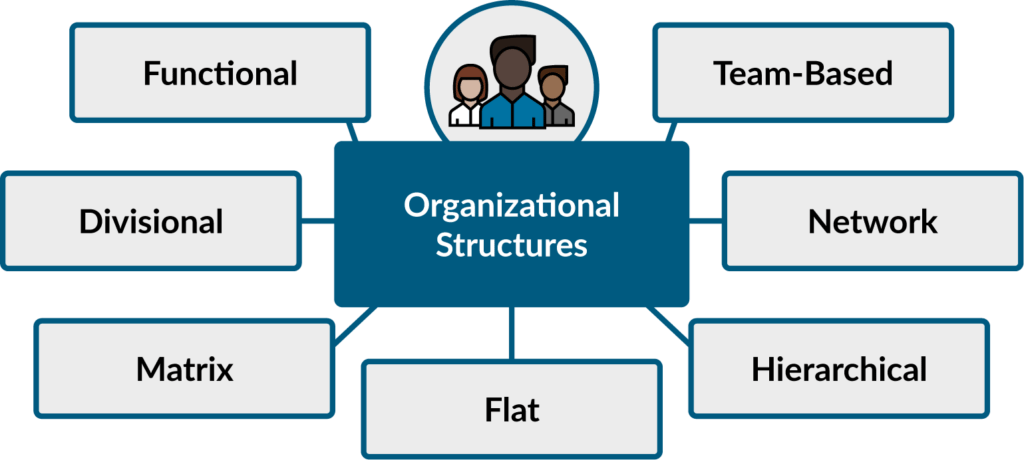
Distill - Find the Key Ideas: This is the most important step. It's about turning raw information into useful knowledge.
Extract key insights.
Map cross-references and surprising connections.
Identify patterns and abstract core principles.
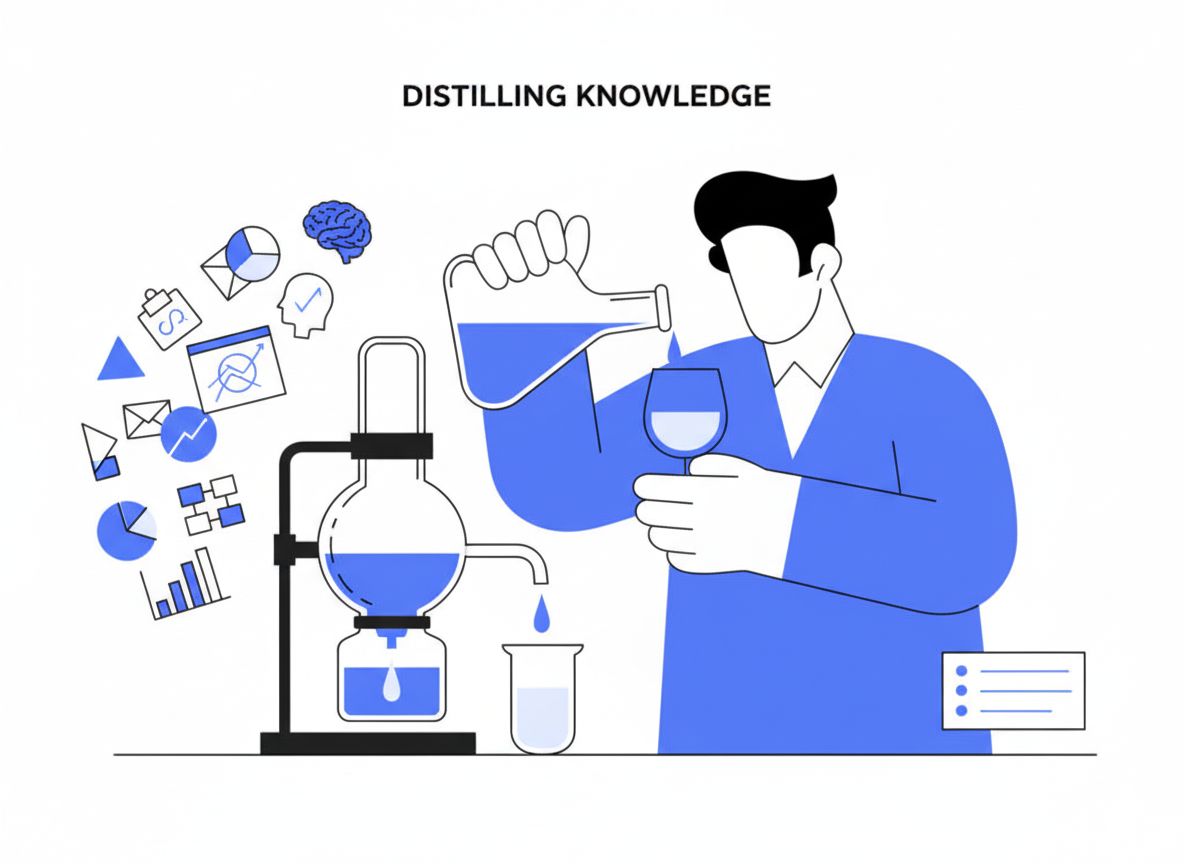
Express - Output and Application: The ultimate goal of learning is to create something new.
Write analyses and reports.
Create projects and implementations.
Develop teaching materials and presentations.
Make strategic plans and decisions.
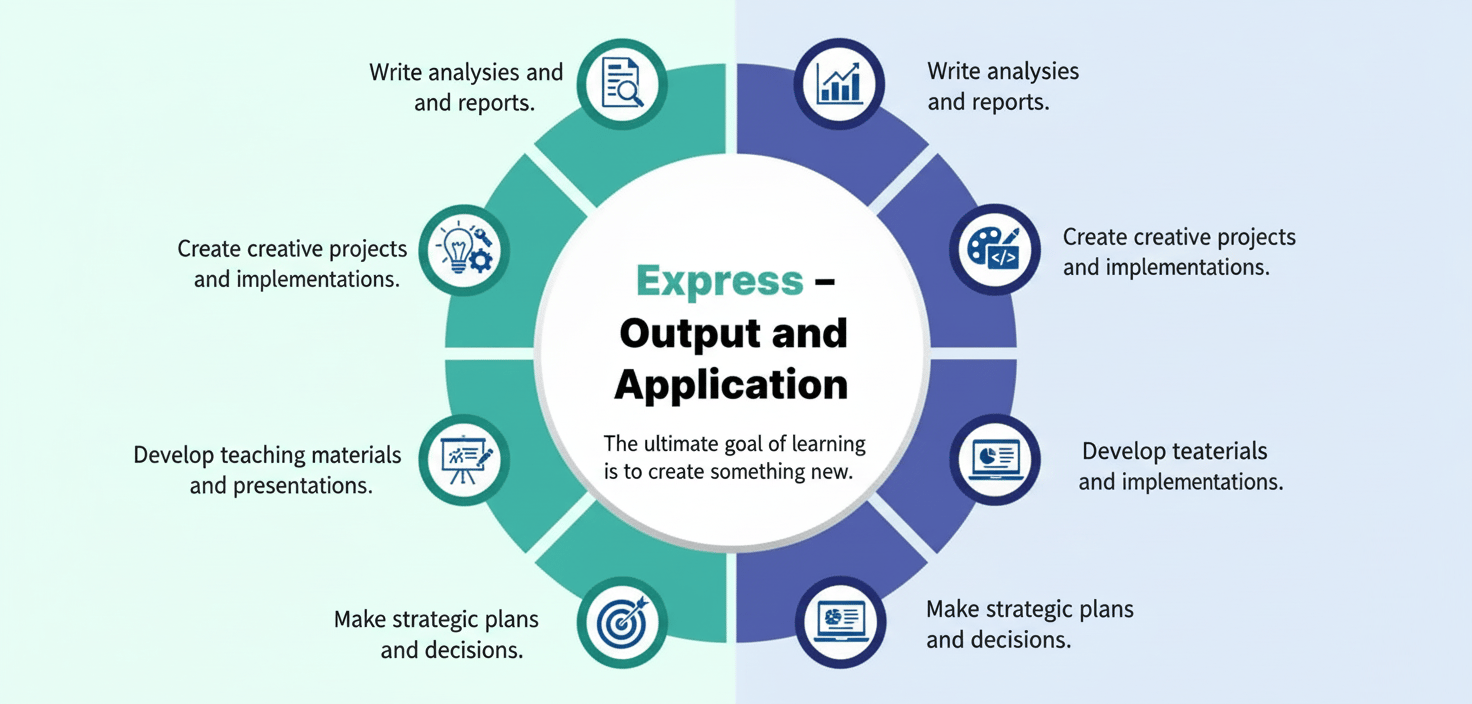
Notion Implementation Guide
Notion is an excellent tool for building your CODA system. Here's a quick way to set it up.
Quick Setup Process:
Create a new Notion workspace.
Establish four main pages: Capture organize, Distill and Express.
Add sub-pages within each section:
Capture: Daily Notes, Meeting Notes, AI Insights.
Organize: By Domains, By Projects, By Resources.
Distill: Key Principles, Mental Models, Synthesis Essays.
Express: Publications, Projects, Creations.
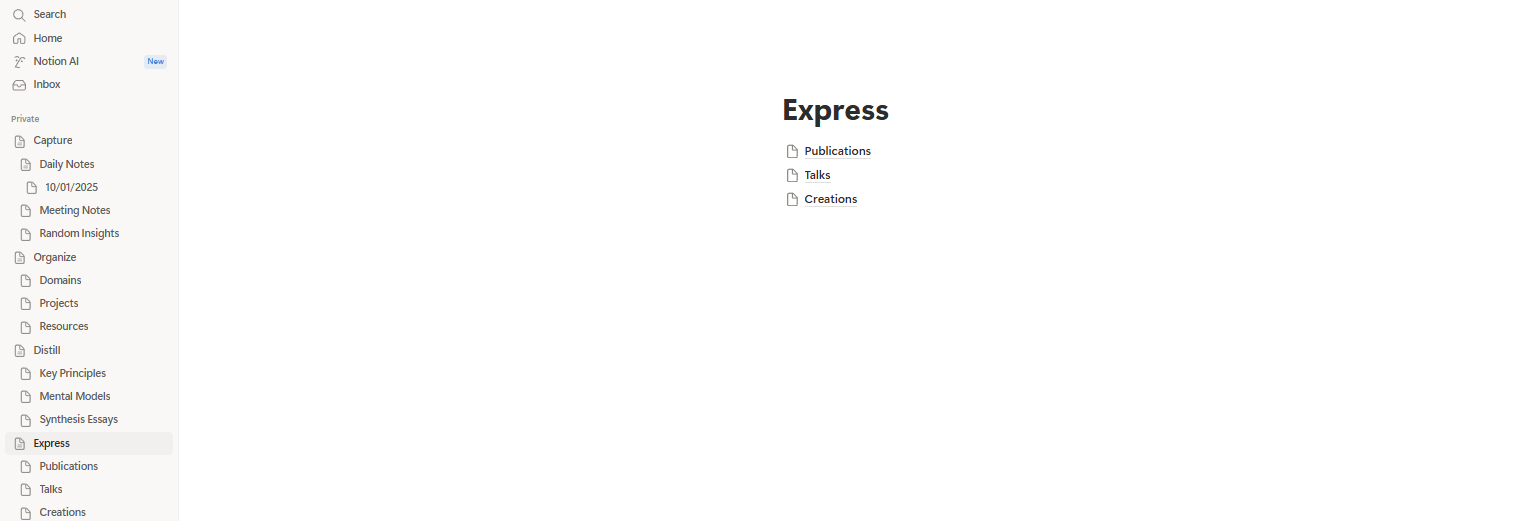
Daily Workflow:
Morning: Review organized knowledge for current projects.
Throughout the Day: Capture new insights and observations as they happen.
Evening: Organize your captured information and look for opportunities to distill key points.
Weekly: Dedicate time to distill key insights and plan your "expression" activities (creating something new).
Advanced Cognitive Training Techniques
To truly supercharge your thinking, use AI in ways that force your brain to work harder. This is true AI-augmented training.
The Reverse Prompting Challenge
This technique flips the script on how you interact with AI, forcing you to be the one doing the thinking.
The Method:
Ask AI to only respond with questions.
Your role is to provide answers until you reach the solution independently.
The AI acts as a guide, pushing your thinking without giving direct answers.
I will present a weak argument on [topic]. Your task is to respectfully but thoroughly critique it, highlighting logical flaws, gaps in evidence and offering alternative perspectives. Here’s my argument: [insert argument] Example Session:
Human: "I need help understanding quantum computing".
AI: "What do you already know about how traditional computers process information?"
Human: "They use binary - 0s and 1s".
AI: "How might quantum particles behave differently from this binary approach?"
(This continues until your understanding emerges naturally through your own answers).
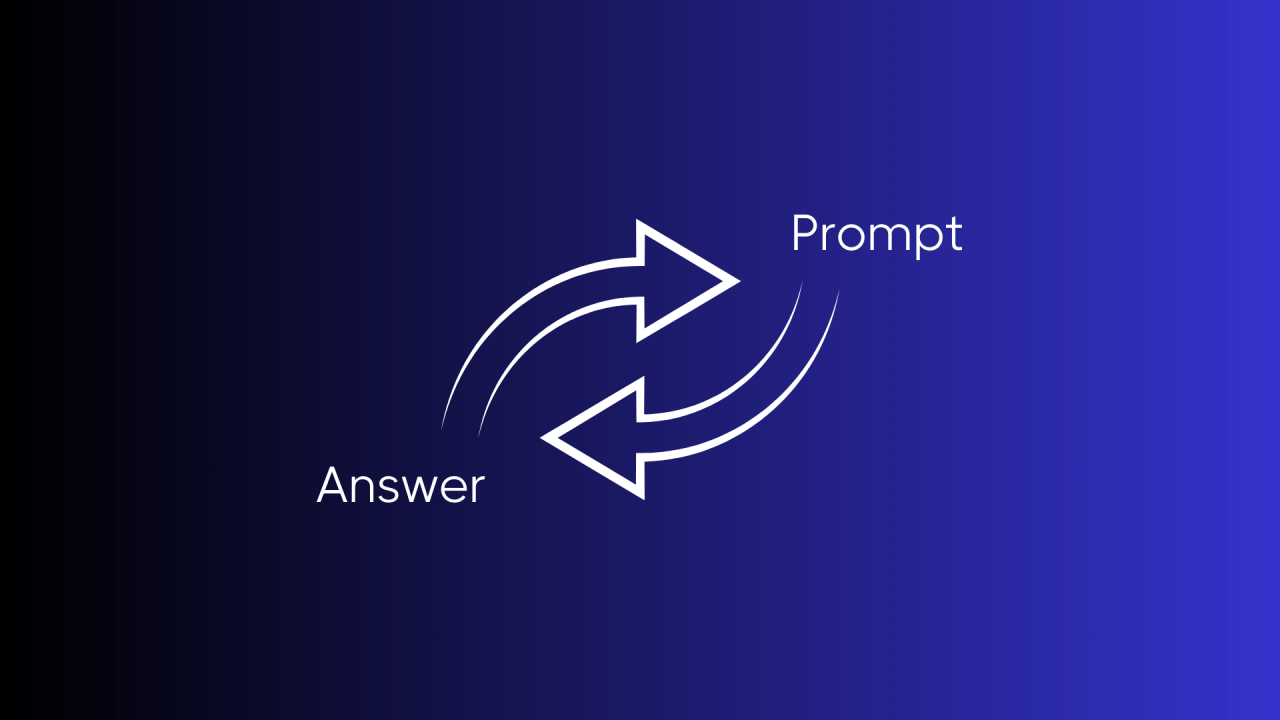
Constraint Mode Training
This powerful technique forces creative thinking by asking AI to provide solutions while operating under specific limits.
The Challenge: Ask AI to explain a concept or solve a problem while adhering to strict constraints.
Time Constraints: "Explain this concept in exactly 60 seconds".
Analogical Constraints: "Use only cooking metaphors to explain this".
Resource Constraints: "Solve this using only materials found in a typical kitchen".
Perspective Constraints: "Explain this from the viewpoint of a medieval peasant".
Assist me in solving [problem/question] but only by asking clarifying questions. Do not give answers or hints - just guide my thought process with questions. I’ll let you know once I’ve reached the solution. The Benefit: These constraints force you to think creatively, form novel neural pathways and adapt your knowledge in unexpected ways.
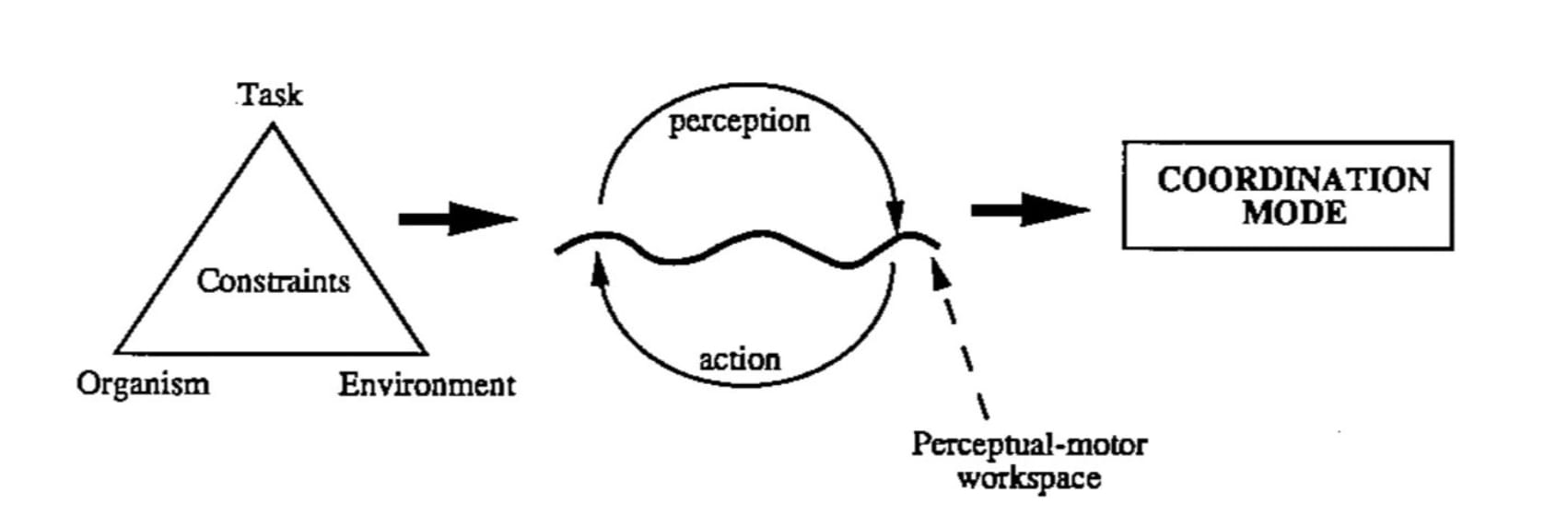
The Socratic Method Integration
Turn AI into your personal Socrates, constantly challenging your assumptions and pushing you to think deeper.
Question Everything: Ask AI to question your assumptions rather than just confirming them.
Seek Contradictions: Request counterarguments to your positions to test their strength.
Explore Edge Cases: Push your ideas to their logical extremes to see where they break down.
Demand Evidence: Require justification for all claims and connections, just as Socrates would.
Present me with rapid-fire challenges on [topic] every 15 seconds. Vary the question types: definitions, practical applications, cross-field connections and creative uses. Continue delivering questions regardless of my answers. After 3 minutes, we’ll review together. 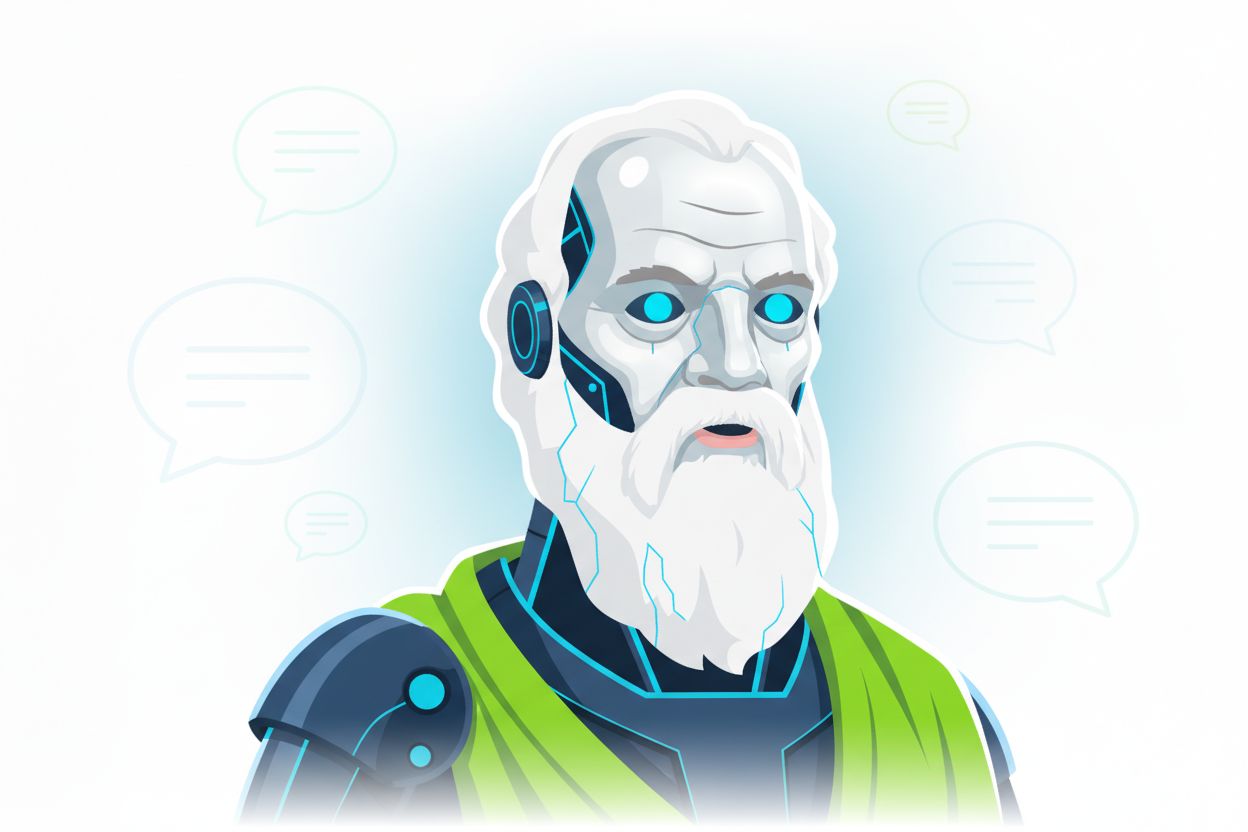
Measuring Your Cognitive Growth
You can't improve what you don't measure. Track your progress to ensure your cognitive abilities are actually growing.
Key Performance Indicators
Weekly Assessments:
Speed of Learning: How long does it take you to grasp new concepts?
Retention Rates: What percentage of information do you recall after a week or a month?
Creative Connections: How many novel insights do you generate per learning session?
Problem-Solving Efficiency: Track trends in how quickly you find solutions.
Monthly Evaluations:
Cross-Domain Integration: How well can you apply principles from one field to another?
Mental Flexibility: How quickly do you adapt when switching between different thinking modes?
Pattern Recognition: Have you improved your ability to identify underlying structures and relationships?
Continuous Optimization
Adjust your training based on your results, just like a fitness coach.
Increase Difficulty: When exercises become too easy, make them harder.
Vary Approaches: Rotate between different cognitive training methods to keep things fresh.
Focus Weak Areas: Spend more time on the domains where you're seeing slower improvement.
Celebrate Progress: Document and acknowledge your cognitive gains to stay motivated.
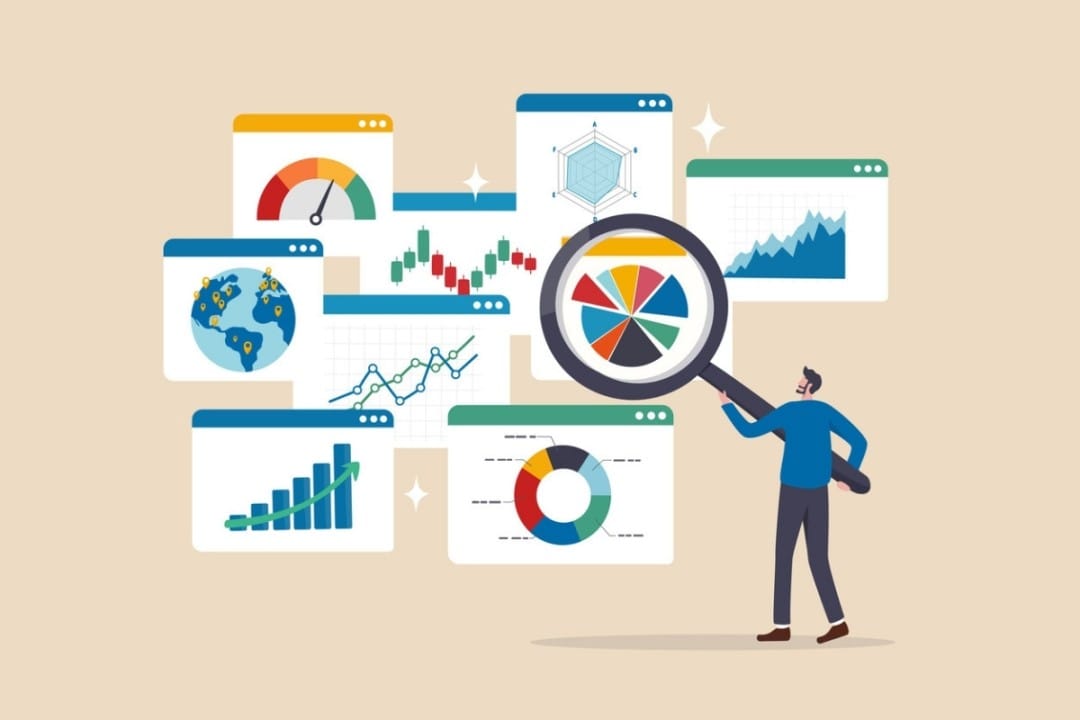
The Future of Human-AI Collaboration
This isn't just about personal growth; it's about preparing for a world where human and AI intelligence merge to create something far more powerful. It's about succeeding in an AI-augmented world.
Preparing for an AI-Augmented World
As AI systems become more sophisticated, your unique human value will increasingly lie in:
Unique Human Capabilities:
Creative Synthesis: Combining different ideas in novel ways.
Ethical Reasoning: Navigating complex moral and social challenges.
Emotional Intelligence: Understanding and managing human dynamics.
Strategic Thinking: Long-term planning and vision development.
AI Partnership Skills:
Effective Prompting: Crafting queries that get the best responses from AI.
Critical Evaluation: Carefully checking AI output and understanding its limits.
Creative Integration: Combining AI's power with your human insights.
Ethical Implementation: Ensuring AI is used responsibly.
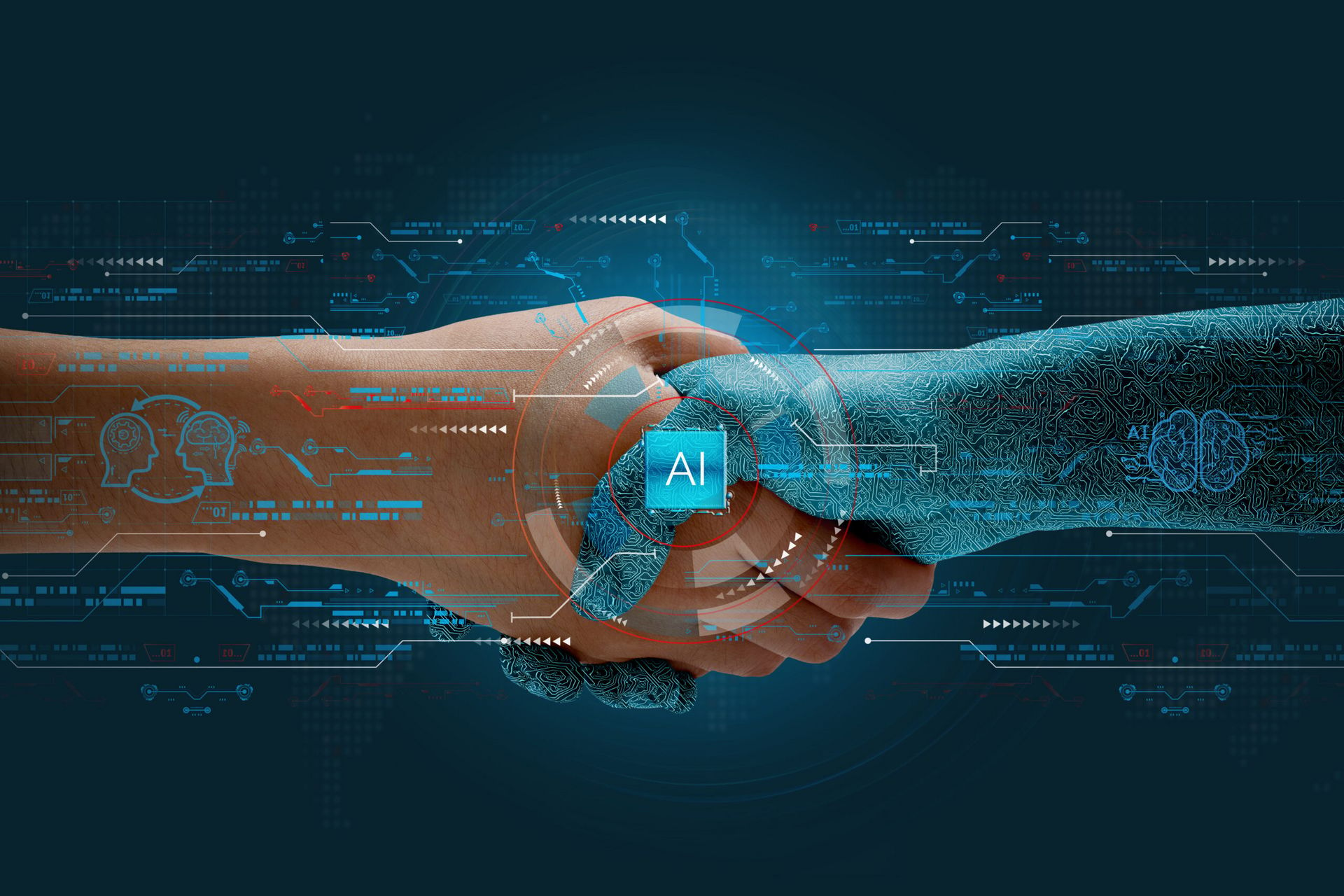
Building Anti-Fragile Intelligence
These AI-augmented workflows help you build "anti-fragile" intelligence. This means your cognitive abilities don't just survive challenges; they actually get stronger under stress and pressure.
Adaptive Learning: Improved ability to master new domains quickly.
Pattern Transfer: Enhanced skill at applying lessons across different contexts.
Creative Problem-Solving: Strengthened capacity for innovative thinking.
Understanding Your Own Thinking: A better understanding of how your own mind works.
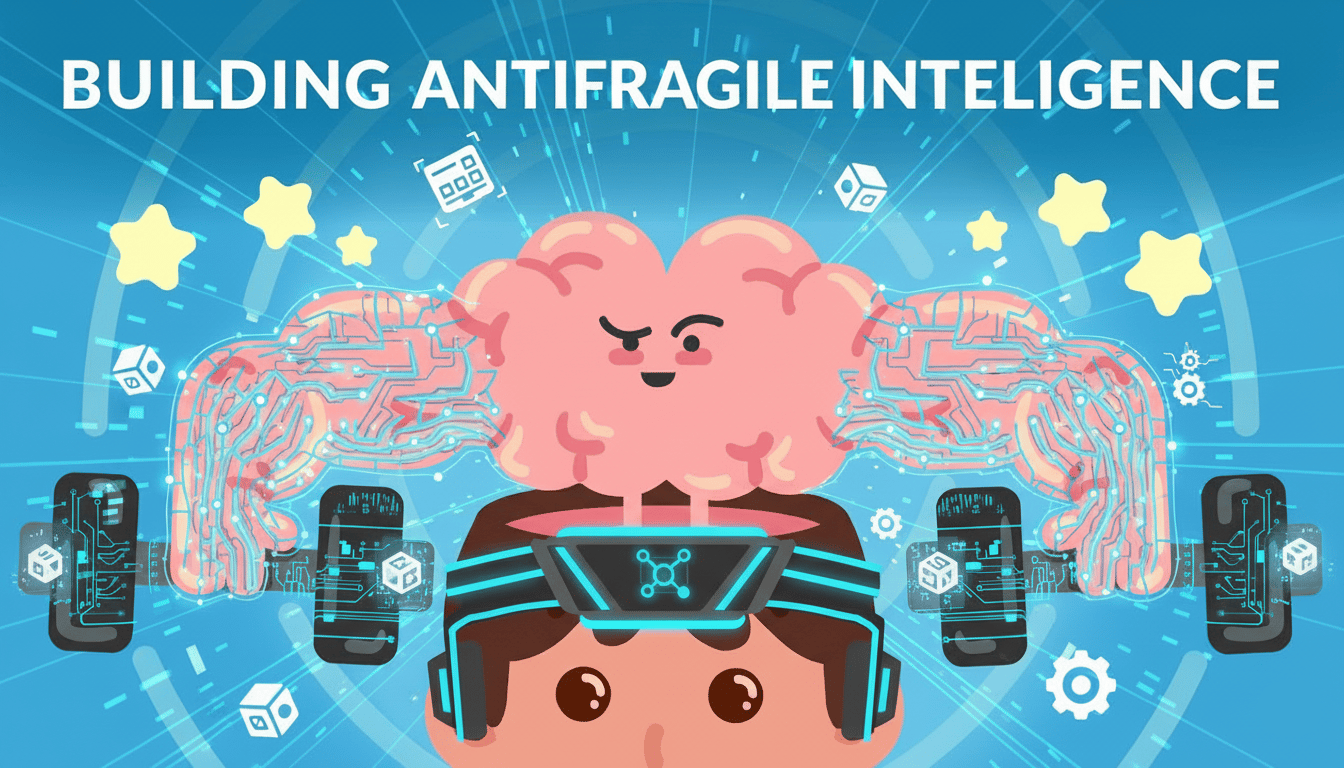
Your 30-Day Transformation Roadmap
This is an actionable, 30-day plan to integrate these powerful workflows into your life and begin your cognitive transformation.
Week 1: Foundation Building
Set up your Gemini mental workout with daily 30-minute workouts.
Create your NotebookLM account and build your first polymath notebook.
Establish your basic Notion workspace with the CODA (Capture organize, Distill, Express) architecture.
Begin your daily cognitive training routine.
Week 2: System Integration
Integrate Anki for spaced repetition learning with your flashcards.
Start using reverse prompting and constraint mode techniques with Gemini.
Develop cross-domain research projects in NotebookLM, actively looking for connections.
Refine and optimize your mental workout based on your initial results and feedback.
Week 3: Advanced Applications
Implement Claude Code automation for flashcard generation (if you have the technical skills).
Create audio and video overviews from your research in NotebookLM.
Begin teaching or presenting your insights to others (this is a powerful way to solidify learning).
Start measuring and tracking your cognitive improvement metrics.
Week 4: Optimization and Scaling
Analyze your performance data and focus on optimizing any weak areas.
Expand your polymath portfolios to new knowledge domains, continuously broadening your expertise.
Develop personal projects that integrate multiple learning streams.
Plan for your long-term cognitive development strategy.
Conclusion: From AI Dependency to AI Partnership
The choice is clear: you can either become part of the 17% who suffer cognitive decline due to passive AI use or you can join the elite group using AI to double their learning speed and creative capabilities.
These three workflows - designing a mental workout, building a polymath portfolio and creating active memory systems - transform AI from a thinking replacement into a thinking amplifier. By treating AI as your thinking partner rather than a crutch, you will develop the advanced thinking skills needed to succeed in an AI-augmented world.

The future belongs to those who don't just use AI; it belongs to those who use AI to become better thinkers, learners and creators.
Your transformation starts now. Choose your first workflow, commit to daily practice and prepare to unlock cognitive abilities you never thought possible.
Remember: In the end, the real winners will be those who successfully combine human and artificial intelligence into something more powerful than either could achieve alone.
If you are interested in other topics and how AI is transforming different aspects of our lives or even in making money using AI with more detailed, step-by-step guidance, you can find our other articles here:
These ChatGPT Prompts Will Blow Your Mind and Show How Amazing Your Skills Can Be
ChatGPT Search: Could It Be the Google Killer?
*indicates a premium content, if any
Overall, how would you rate the AI Workflows Series? |
Reply